Paul van Yperen's Blog, page 264
August 4, 2018
Yoko Tani
Porcelain pretty Yoko Tani (1928–1999) was a French-born Japanese actress and a sensual nightclub entertainer too. She appeared in many French films, but also played starring roles in Japanese, British, American, Canadian and even East-German productions.
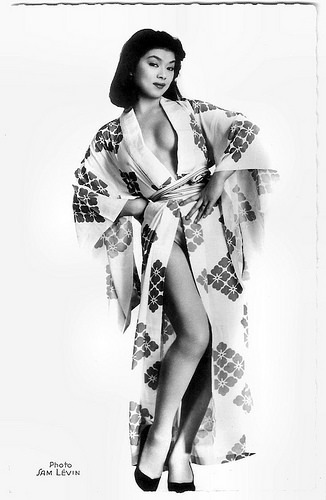
French postcard by Editions du Globe (E.D.U.G.), Paris, no. 469. Photo: Sam Lévin.
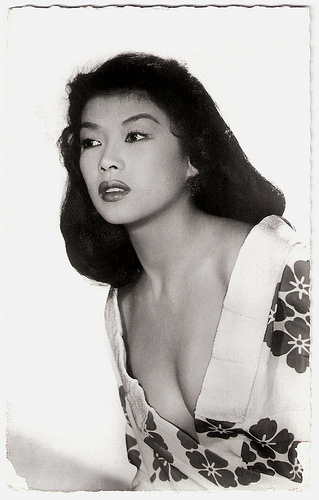
French postcard by Editions du Globe (E.D.U.G.), Paris, no. 713. Photo: Sam Lévin.
Sexy ‘Geisha’ Dances
Yoko Tani was born as Itani Yōko (猪谷洋子) in Paris, France in 1928. She was the daughter of the Japanese ambassador in France and she had a younger sister, Aiko.
She has occasionally been described as 'Eurasian', 'half-French', 'half-Japanese', and even 'Italian-Japanese'. Wikipedia claims that all these descriptions are incorrect: "According to contemporary French sources, her father and mother were attached to the Japanese embassy in Paris, and Tani herself was conceived en route during a shipboard passage from Japan to Europe in 1927, hence given the name Yōko, one reading of which can mean ‘ocean-child.’
Japanese sources indicate that the family returned to Japan in 1930, when Yoko still was a toddler, and she did not return to France until 1950, when her schooling was completed". The Wikipedia author doubts this while there were severe restrictions on Japanese travelling outside Japan directly after WW II. However, the Japanese sources state that Itani had attended an elite Catholic girls' school in Tokyo, and through it secured a Catholic scholarship to study at the University of Paris.
Installing herself in Montmartre, she developed an immediate attraction to cabarets, nightclubs, and music-halls. Setting herself up as an exotic oriental beauty she quickly established a reputation for her provocatively sexy ‘geisha’ dances, which generally ended with her slipping out of her kimono.
It was here she was spotted by famous director Marcel Carné, who took her into his circle of artistic friends, including French actor Roland Lesaffre, whom she would marry in 1956.
As a result, she began to get bit parts in films - starting as a Japanese dancer, in Le port du désir/House on the Waterfront (Edmond T. Gréville, 1954) starring Jean Gabin - and on the stage, with a role as the blue lotus in la Petite Maison de Thé (a French adaptation of The Teahouse of the August Moon) at the Théâtre Montparnasse.
Other films in which she had small roles that year were the crime drama Les Clandestines/Vice Dolls (Raoul André, 1954) with Philippe Lemaire , the Fernandel comedy Ali Baba et les Quarante voleurs/Ali Baba and the Forty Thieves (Jacques Becker, 1954), Marchandes d'illusions/Nights of Shame (Raoul André, 1954) with Nicole Courcel , the crime film Les pépées font la loi/The Chicks Make the law (Raoul André, 1954) with Dominique Wilms , and the German production Verrat an Deutschland/Betrayal of Germany (Veit Harlan, 1954) starring Kristina Söderbaum .

French postcard by Editions du Globe (E.D.U.G.), Paris, no. 787. Photo: Studio Vauclair.
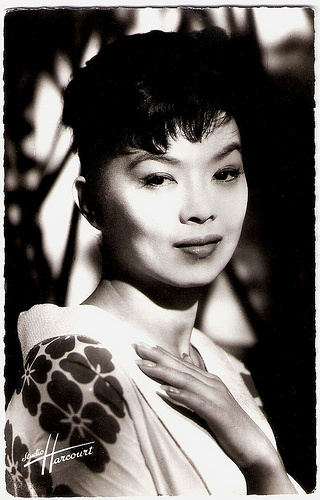
French postcard by Editions du Globe (E.D.U.G.), Paris, no. 800. Photo: Studio Harcourt.
Absolutely Beguiling
Yoko Tani's involvement with cinema was, up to the mid 1950s, limited entirely to that of portraying stereotyped Orientals in French films.
With the end of the US occupation of Japan in 1952, however, postwar Japanese cinema itself burst upon the French scene, culminating in the years 1955 and 1956 when a total of six Japanese films, including Ikimono no Kiroku/I Live in Fear (Akira Kurosawa, 1955), were entered at the Cannes film festival.
At Cannes, Tani made contact with directors Akira Kurosawa and Hisamatsu Seiji, which led to a trip to Japan in 1956 by Tani and Lesaffre, and their joint appearance in the Toho production Fukuaki no seishun/Barefoot Youth (Taniguchi Senkichi, 1956). It was originally intended that the film would be directed by Kurosawa himself, but in the end it fell to his Toho colleague Taniguchi Senkichi. Tani and Lesaffre's ambition was to bring the film back to France and release it in the French market, an aim which was never achieved.
During the same trip, and also for Toho, Tani took a small role in Jōshû to tomo ni/Women in Prison (Hisamatsu Seiji, 1956), in which she played a westernised Japanese Catholic named Mary. This film, now virtually unobtainable, starred the legendary Japanese stars Hara Setsuko and Tanaka Kinuyo.
Early in 1957 Tani appeared in a small role in her first English-language film: the MGM production of Graham Greene's The Quiet American (Joseph L. Mankiewicz, 1957), a political drama set in French Indochina starring Audie Murphy and Michael Redgrave . The American production was shot entirely in Rome with additional location scenes of Saigon. Tani played a francophone Vietnamese nightclub hostess.
She had her breakthrough in English-language cinema came with the war-time love story The Wind Cannot Read (Ralph Thomas, 1959). Gary Brumburgh at IMDb notes about her performance: “The cameras displayed a lovely, quiet beauty in the 1950's and she was absolutely beguiling”. The film had originally been a project of the British producer Alexander Korda, and was to have been directed by David Lean, who in 1955 travelled to Japan with author Richard Mason and cast Japanese actress Kishi Keiko as the female lead. At a very advanced stage, the project fell apart, and a few months later Korda died.
The pieces were eventually picked up by the Rank Organisation, and it was decided to produce the film using the script and locations already set out by Lean, with one of Rank's big stars, Dirk Bogarde , in the male lead as a British POW in a Japanese camp. Tani played his ill wife.
The film was a modest commercial success, and lead to further roles in British co-productions - as the Inuit Asiak in the Anglo-French-Italian The Savage Innocents (Nicholas Ray, 1959) with Anthony Quinn , and as the ingenue Seraphina in the crime drama Piccadilly Third Stop (Wolf Rilla, 1960).
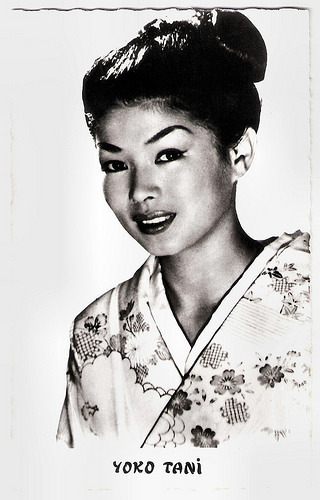
Vintage card, no. 914.
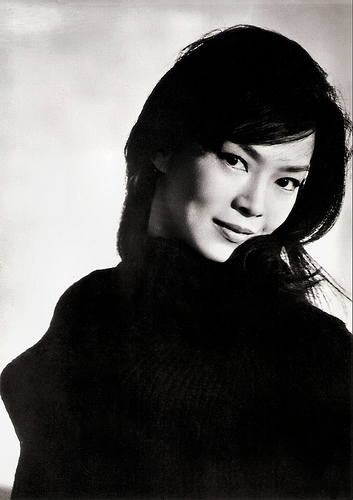
Italian postcard by Alterocca, Terni, no. 49142.
Meek Princess in Distress
Aside from The Quiet American, Yoko Tani’s only other Hollywood roles were in the comedy My Geisha (Jack Cardiff, 1962) starring Shirley MacLaine and Yves Montand - shot, however, on location in Japan - and the lively sex-comedy Who's Been Sleeping in My Bed? (Daniel Mann, 1963) with Dean Martin as a womanising soap-opera star.
Usually type-cast as an exotic, Tani nevertheless got to play unusual roles as a result. She portrayed Japanese medical doctor Sumiko Ogimura in one of the few Communist-bloc Sci-Fi films, the East-German/Polish film adaptation of Stanisław Lem's novel The Astronauts, Der schweigende Stern/Milcząca Gwiazda/First Spaceship on Venus (Kurt Maetzig, Hieronim Przybył, 1959).
Perhaps even more unusual (for the time) was her trip to the Vancouver Islands in Canada to play the role of Mary Ota in The Sweet and the Bitter (James Clavell, 1962-1967), which treated the aftermath of the wartime internment of Canadian Japanese and the loss of their properties and their businesses.
In Italy she became a customary player of meek princess-in-distress types in such Peplums as Maciste alla corte del Gran Khan/Maciste at the Court of the Great Khan (Riccardo Freda, 1961) starring muscleman Gordon Scott , and Ursus e la ragazza tartara/The Tartar Invasion (Remigio Del Grosso, 1961), which co-starred her husband, Roland Lesaffre.
In 1962, she returned to France. Her marriage to Lesaffre, who maintained an ongoing, homosexual liaison with Marcel Carné, was childless. It ended in divorce in 1962.
From this point on, she was to be more strictly Europe-based and to take on work mainly as a femme fatale in Eurospy films as OSS 77 – Operazione fior di loto/OSS77 – Operation Lotus (Bruno Paolinelli, 1967) with Dominique Boschero , and in the final two episodes of the popular British TV series Danger Man/Secret Agent, featuring Patrick McGoohan . These episodes – filmed in colour - were combined into one feature-length film, Koroshi (Michael Truman, Peter Yates, 1967) that was released theatrically in several countries.
Despite her involvement with film, Tani never abandoned her attachment to nightclub and cabaret. She worked as a stripper in the well-known Le Crazy Horse de Paris and other girlie clubs. Even as late as 1977, she had a small role in the Brazilian sexploitation thriller O Estripador de Mulheres/The Women Ripper (Juan Bajon, 1977). That year she also starred in a transvestite show in downtown São Paulo.
Her final film was the French comedy Ça fait tilt!/Tilt (André Hunebelle, 1978) with Bernard Menez and Eleonora Giorgi. On TV her final appearance was as a madam in the erotic anthology Serie rose/Softly from Paris (Walerian Borowczyk, 1986).
In later life Tani remarried, wedding Roger Laforet, a native of the seaside village of Binic in Brittany. A wealthy industrialist, Laforet was an associate of Baron Marcel Bich, co-founder of the BIC consumer products empire. Tani's declining years were spent between Paris and their house in Paimpol overlooking the sea. Gary Brumburgh adds at IMDb : “In later years she enjoyed painting and was devoted to her religion and her dog that she named ‘Toto’.”
Yoko Tani died of cancer in 1999 in Paris, after a long illness. She is buried in Binic, together with Laforet. Their tomb carries the Breton inscription «Ganeoc'h Bepred» (roughly, "Always With You"). Her late husband, Ronald Lesaffre, is buried together with Marcel Carné in his grave in the Cimetière Saint-Vincent in Montmartre.
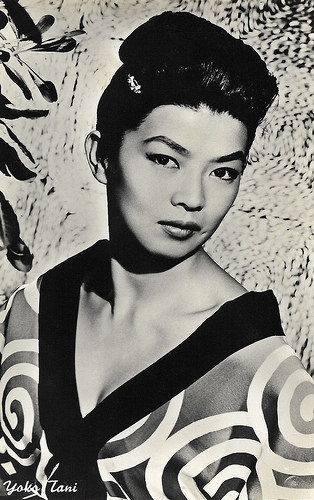
Italian postcard by Bromofoto, Milano, no. 1391. Sadly the edges above and at right of the card were cut off by a former owner.
German trailer of Der schweigende Stern/Milcząca Gwiazda/First Spaceship on Venus (1959). Source: DEFA Stiftung (YouTube).
Source: (IMDb), Hal Erickson (AllMovie), Wikipedia and .

French postcard by Editions du Globe (E.D.U.G.), Paris, no. 469. Photo: Sam Lévin.

French postcard by Editions du Globe (E.D.U.G.), Paris, no. 713. Photo: Sam Lévin.
Sexy ‘Geisha’ Dances
Yoko Tani was born as Itani Yōko (猪谷洋子) in Paris, France in 1928. She was the daughter of the Japanese ambassador in France and she had a younger sister, Aiko.
She has occasionally been described as 'Eurasian', 'half-French', 'half-Japanese', and even 'Italian-Japanese'. Wikipedia claims that all these descriptions are incorrect: "According to contemporary French sources, her father and mother were attached to the Japanese embassy in Paris, and Tani herself was conceived en route during a shipboard passage from Japan to Europe in 1927, hence given the name Yōko, one reading of which can mean ‘ocean-child.’
Japanese sources indicate that the family returned to Japan in 1930, when Yoko still was a toddler, and she did not return to France until 1950, when her schooling was completed". The Wikipedia author doubts this while there were severe restrictions on Japanese travelling outside Japan directly after WW II. However, the Japanese sources state that Itani had attended an elite Catholic girls' school in Tokyo, and through it secured a Catholic scholarship to study at the University of Paris.
Installing herself in Montmartre, she developed an immediate attraction to cabarets, nightclubs, and music-halls. Setting herself up as an exotic oriental beauty she quickly established a reputation for her provocatively sexy ‘geisha’ dances, which generally ended with her slipping out of her kimono.
It was here she was spotted by famous director Marcel Carné, who took her into his circle of artistic friends, including French actor Roland Lesaffre, whom she would marry in 1956.
As a result, she began to get bit parts in films - starting as a Japanese dancer, in Le port du désir/House on the Waterfront (Edmond T. Gréville, 1954) starring Jean Gabin - and on the stage, with a role as the blue lotus in la Petite Maison de Thé (a French adaptation of The Teahouse of the August Moon) at the Théâtre Montparnasse.
Other films in which she had small roles that year were the crime drama Les Clandestines/Vice Dolls (Raoul André, 1954) with Philippe Lemaire , the Fernandel comedy Ali Baba et les Quarante voleurs/Ali Baba and the Forty Thieves (Jacques Becker, 1954), Marchandes d'illusions/Nights of Shame (Raoul André, 1954) with Nicole Courcel , the crime film Les pépées font la loi/The Chicks Make the law (Raoul André, 1954) with Dominique Wilms , and the German production Verrat an Deutschland/Betrayal of Germany (Veit Harlan, 1954) starring Kristina Söderbaum .

French postcard by Editions du Globe (E.D.U.G.), Paris, no. 787. Photo: Studio Vauclair.

French postcard by Editions du Globe (E.D.U.G.), Paris, no. 800. Photo: Studio Harcourt.
Absolutely Beguiling
Yoko Tani's involvement with cinema was, up to the mid 1950s, limited entirely to that of portraying stereotyped Orientals in French films.
With the end of the US occupation of Japan in 1952, however, postwar Japanese cinema itself burst upon the French scene, culminating in the years 1955 and 1956 when a total of six Japanese films, including Ikimono no Kiroku/I Live in Fear (Akira Kurosawa, 1955), were entered at the Cannes film festival.
At Cannes, Tani made contact with directors Akira Kurosawa and Hisamatsu Seiji, which led to a trip to Japan in 1956 by Tani and Lesaffre, and their joint appearance in the Toho production Fukuaki no seishun/Barefoot Youth (Taniguchi Senkichi, 1956). It was originally intended that the film would be directed by Kurosawa himself, but in the end it fell to his Toho colleague Taniguchi Senkichi. Tani and Lesaffre's ambition was to bring the film back to France and release it in the French market, an aim which was never achieved.
During the same trip, and also for Toho, Tani took a small role in Jōshû to tomo ni/Women in Prison (Hisamatsu Seiji, 1956), in which she played a westernised Japanese Catholic named Mary. This film, now virtually unobtainable, starred the legendary Japanese stars Hara Setsuko and Tanaka Kinuyo.
Early in 1957 Tani appeared in a small role in her first English-language film: the MGM production of Graham Greene's The Quiet American (Joseph L. Mankiewicz, 1957), a political drama set in French Indochina starring Audie Murphy and Michael Redgrave . The American production was shot entirely in Rome with additional location scenes of Saigon. Tani played a francophone Vietnamese nightclub hostess.
She had her breakthrough in English-language cinema came with the war-time love story The Wind Cannot Read (Ralph Thomas, 1959). Gary Brumburgh at IMDb notes about her performance: “The cameras displayed a lovely, quiet beauty in the 1950's and she was absolutely beguiling”. The film had originally been a project of the British producer Alexander Korda, and was to have been directed by David Lean, who in 1955 travelled to Japan with author Richard Mason and cast Japanese actress Kishi Keiko as the female lead. At a very advanced stage, the project fell apart, and a few months later Korda died.
The pieces were eventually picked up by the Rank Organisation, and it was decided to produce the film using the script and locations already set out by Lean, with one of Rank's big stars, Dirk Bogarde , in the male lead as a British POW in a Japanese camp. Tani played his ill wife.
The film was a modest commercial success, and lead to further roles in British co-productions - as the Inuit Asiak in the Anglo-French-Italian The Savage Innocents (Nicholas Ray, 1959) with Anthony Quinn , and as the ingenue Seraphina in the crime drama Piccadilly Third Stop (Wolf Rilla, 1960).

Vintage card, no. 914.

Italian postcard by Alterocca, Terni, no. 49142.
Meek Princess in Distress
Aside from The Quiet American, Yoko Tani’s only other Hollywood roles were in the comedy My Geisha (Jack Cardiff, 1962) starring Shirley MacLaine and Yves Montand - shot, however, on location in Japan - and the lively sex-comedy Who's Been Sleeping in My Bed? (Daniel Mann, 1963) with Dean Martin as a womanising soap-opera star.
Usually type-cast as an exotic, Tani nevertheless got to play unusual roles as a result. She portrayed Japanese medical doctor Sumiko Ogimura in one of the few Communist-bloc Sci-Fi films, the East-German/Polish film adaptation of Stanisław Lem's novel The Astronauts, Der schweigende Stern/Milcząca Gwiazda/First Spaceship on Venus (Kurt Maetzig, Hieronim Przybył, 1959).
Perhaps even more unusual (for the time) was her trip to the Vancouver Islands in Canada to play the role of Mary Ota in The Sweet and the Bitter (James Clavell, 1962-1967), which treated the aftermath of the wartime internment of Canadian Japanese and the loss of their properties and their businesses.
In Italy she became a customary player of meek princess-in-distress types in such Peplums as Maciste alla corte del Gran Khan/Maciste at the Court of the Great Khan (Riccardo Freda, 1961) starring muscleman Gordon Scott , and Ursus e la ragazza tartara/The Tartar Invasion (Remigio Del Grosso, 1961), which co-starred her husband, Roland Lesaffre.
In 1962, she returned to France. Her marriage to Lesaffre, who maintained an ongoing, homosexual liaison with Marcel Carné, was childless. It ended in divorce in 1962.
From this point on, she was to be more strictly Europe-based and to take on work mainly as a femme fatale in Eurospy films as OSS 77 – Operazione fior di loto/OSS77 – Operation Lotus (Bruno Paolinelli, 1967) with Dominique Boschero , and in the final two episodes of the popular British TV series Danger Man/Secret Agent, featuring Patrick McGoohan . These episodes – filmed in colour - were combined into one feature-length film, Koroshi (Michael Truman, Peter Yates, 1967) that was released theatrically in several countries.
Despite her involvement with film, Tani never abandoned her attachment to nightclub and cabaret. She worked as a stripper in the well-known Le Crazy Horse de Paris and other girlie clubs. Even as late as 1977, she had a small role in the Brazilian sexploitation thriller O Estripador de Mulheres/The Women Ripper (Juan Bajon, 1977). That year she also starred in a transvestite show in downtown São Paulo.
Her final film was the French comedy Ça fait tilt!/Tilt (André Hunebelle, 1978) with Bernard Menez and Eleonora Giorgi. On TV her final appearance was as a madam in the erotic anthology Serie rose/Softly from Paris (Walerian Borowczyk, 1986).
In later life Tani remarried, wedding Roger Laforet, a native of the seaside village of Binic in Brittany. A wealthy industrialist, Laforet was an associate of Baron Marcel Bich, co-founder of the BIC consumer products empire. Tani's declining years were spent between Paris and their house in Paimpol overlooking the sea. Gary Brumburgh adds at IMDb : “In later years she enjoyed painting and was devoted to her religion and her dog that she named ‘Toto’.”
Yoko Tani died of cancer in 1999 in Paris, after a long illness. She is buried in Binic, together with Laforet. Their tomb carries the Breton inscription «Ganeoc'h Bepred» (roughly, "Always With You"). Her late husband, Ronald Lesaffre, is buried together with Marcel Carné in his grave in the Cimetière Saint-Vincent in Montmartre.

Italian postcard by Bromofoto, Milano, no. 1391. Sadly the edges above and at right of the card were cut off by a former owner.
German trailer of Der schweigende Stern/Milcząca Gwiazda/First Spaceship on Venus (1959). Source: DEFA Stiftung (YouTube).
Source: (IMDb), Hal Erickson (AllMovie), Wikipedia and .
Published on August 04, 2018 22:00
August 3, 2018
Photo by Frieda Riess
Lately, there has been a revival of interest in photographer Frieda Riess (1890-ca. 1955), who had a studio in central Berlin. In Germany, a biography was published and in 1908, the Berlinische Galerie had a major exhibition with Riess'portraits. Her sitters included Albert Einstein, Benito Mussolini, Josephine Baker, Jack Dempsey and many film stars. She also worked as the stills photographer on Fritz Lang’s films.
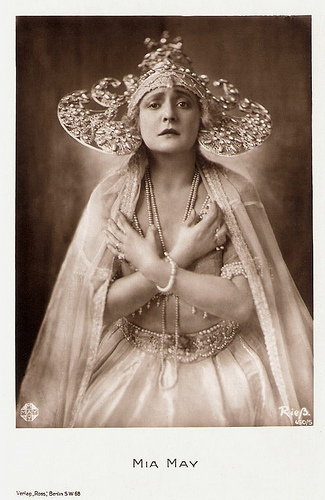
Mia May . German postcard by Ross Verlag, no. 450/5, 1919-1924. Photo: May-Film / Riess. Possibly for Die Herrin der Welt/The Mistress of the World (Joe May a.o., 1919).
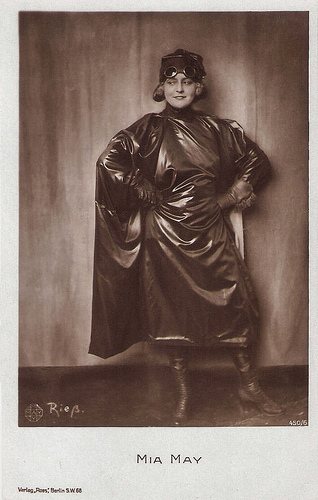
Mia May . German Postcard by Ross Verlag, no. 450/6, 1919-1924. Photo: May Film / Riess. Possibly for Die Herrin der Welt/The Mistress of the World (Joe May a.o., 1919).
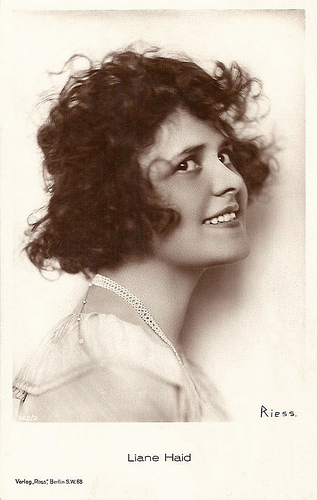
Liane Haid . German postcard by Ross Verlag, Berlin, no. 462/2, 1919-1924. Photo: Riess.
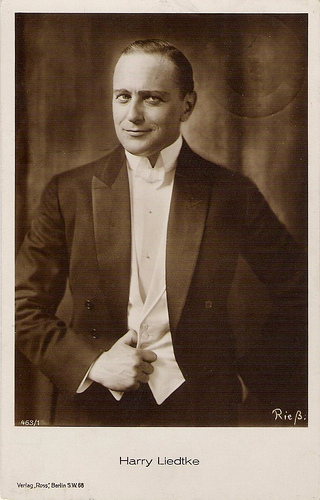
Harry Liedtke . German postcard by Ross Verlag, no. 463/1, 1919-1924. Photo: Riess.
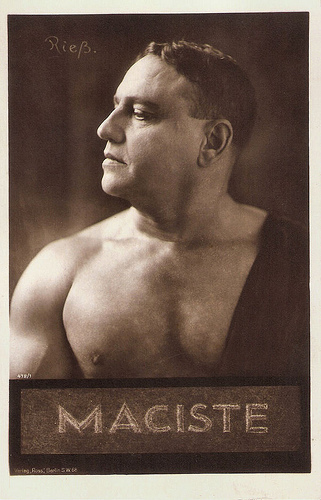
Bartolomeo Pagano aka Maciste. German postcard by Ross Verlag, no. 478/1, 1919-1924. Photo: Riess.
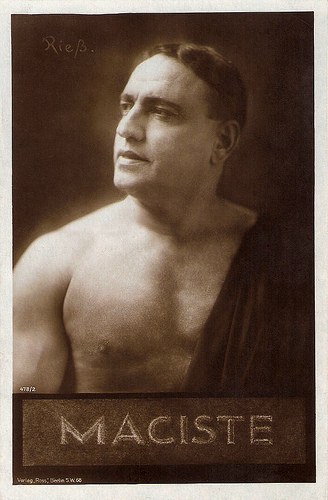
Bartolomeo Pagano aka Maciste. German postcard by Ross Verlag, no. 478/2, 1919-1924. Photo: Riess.
An exclusive meeting place for Berlin celebrities
Frieda Riess was born in Czarnikau in the Western Prussian town of Czarnikau (now Carnkov in Poland) in the province of Poznán where her German-Jewish parents were shopkeepers.
At the end of the 1890s, the family moved to Berlin where she first studied sculpture under Hugo Lederer (c. 1907) and later photography at the Berlin 'Photographischen Lehranstalt' of the Lette Verein (she later inspired photographer Marianne Breslauer to enrol there too). Riess received her diploma in the summer of 1915.
In 1918, she opened a studio (in German: atelier) on the prestigious Kurfürstendamm. It became one of the most popular studios in the city. Partly as a result of her marriage to the poet and journalist Rudolf Leonhard in the early 1920s, her social connections extended through Berlin’s art world of the 1920s. Her studio became an exclusive meeting place at exhibition openings.
Her clientele included such celebrities as playwright Walter Hasenclever, novelist Gerhart Hauptmann and actors and actresses including Tilla Durieux, Asta Nielsen , Mia May and her daughter Eva May , and Emil Jannings . In addition, she contributed to the journals and magazines of the day including Die Dame, Berliner Illustrierte Zeitung, Der Weltspiegel, Querschnit and Koralle.
Like her colleagues Hugo Erfurth, Madame D´Ora, Lotte Jacobi and Edward Steichen, Riess became a master of the advanced art of portraiture. The solo exhibition of 177 portraits in Alfred Flechtheim’s gallery in 1925 played a decisive part in this appreciation of the photographer. Flechtheim was one of the leading collectors and dealers in modern art during the 1920s. At that time it was somewhat surprising for one of Berlin’s leading art dealers to show photographs, and the fact that he refers to photography as art invited particular attention.
Riess travelled to Paris, London and Rome, where she moved in similar literary and aristocratic circles. While on a trip to Italy in 1929, she was invited to photograph Benito Mussolini.
Why she doesn’t rate a mention in histories of German photography until recently? Part of that was through her design. Since 1930 Frieda Riess had a liaison with the elderly French ambassador to Berlin, Pierre de Margerie. In 1932, they married and moved to Paris. She retreated from photography and Berlin society. She disappeared from the public eye.
From 1940 to 1945, she survived the German occupation of Paris in seclusion, and died there in the mid 1950s. The date of her death cannot be clearly established and her place of burial remains unknown.
In 2008, a retrospective of the work of Frieda Riess was held in the Berlinische Galerie. That year Thomas Ehrsam published 'Die Riess: fotografisches Atelier und Salon in Berlin 1918-1932'.
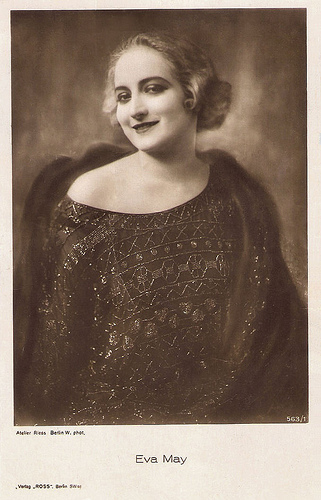
Eva May . German postcard by Ross Verlag, no. 563/1, 1919-1924. Photo: Atelier Riess.
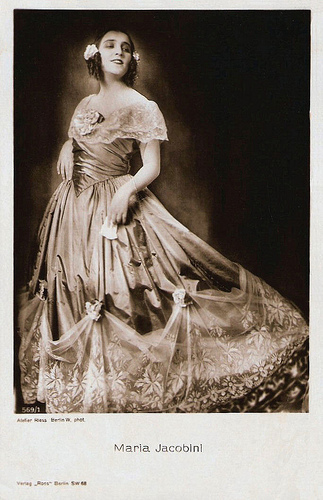
Maria Jacobini . German postcard by Ross Verlag, Berlin, no. 569/1, 1919-1924. Photo: Atelier Riess, Berlin.
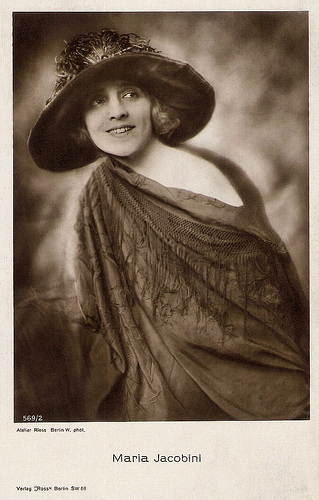
Maria Jacobini . German postcard by Ross Verlag, Berlin, no. 569/2, 1919-1924. Photo: Atelier Riess, Berlin.
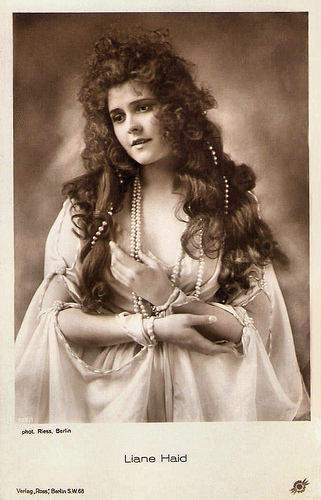
Liane Haid . German postcard by Ross Verlag, no. 1023/1, 1927-1928. Photo: Riess, Berlin.
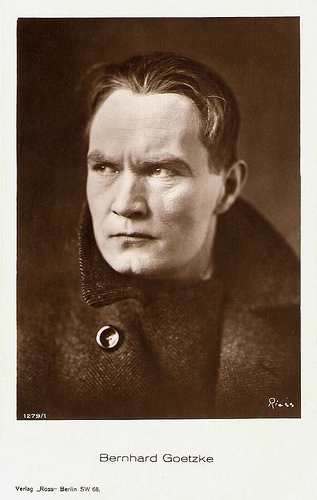
Bernhard Goetzke . German postcard by Ross Verlag, no. 1279/1, 1927-1928. Photo: Riess.
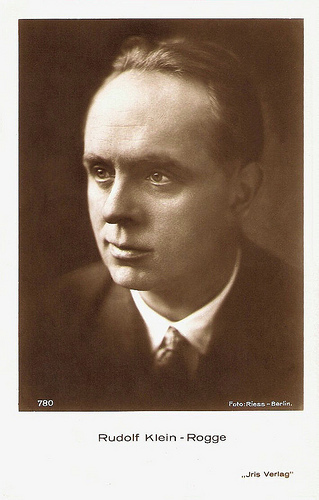
Rudolf Klein-Rogge . Austrian postcard by Iris Verlag no. 780. Photo: Riess, Berlin.
Sources: Kraftgenie (Weimar), One Man's Treasure and Wikipedia.

Mia May . German postcard by Ross Verlag, no. 450/5, 1919-1924. Photo: May-Film / Riess. Possibly for Die Herrin der Welt/The Mistress of the World (Joe May a.o., 1919).

Mia May . German Postcard by Ross Verlag, no. 450/6, 1919-1924. Photo: May Film / Riess. Possibly for Die Herrin der Welt/The Mistress of the World (Joe May a.o., 1919).

Liane Haid . German postcard by Ross Verlag, Berlin, no. 462/2, 1919-1924. Photo: Riess.

Harry Liedtke . German postcard by Ross Verlag, no. 463/1, 1919-1924. Photo: Riess.

Bartolomeo Pagano aka Maciste. German postcard by Ross Verlag, no. 478/1, 1919-1924. Photo: Riess.

Bartolomeo Pagano aka Maciste. German postcard by Ross Verlag, no. 478/2, 1919-1924. Photo: Riess.
An exclusive meeting place for Berlin celebrities
Frieda Riess was born in Czarnikau in the Western Prussian town of Czarnikau (now Carnkov in Poland) in the province of Poznán where her German-Jewish parents were shopkeepers.
At the end of the 1890s, the family moved to Berlin where she first studied sculpture under Hugo Lederer (c. 1907) and later photography at the Berlin 'Photographischen Lehranstalt' of the Lette Verein (she later inspired photographer Marianne Breslauer to enrol there too). Riess received her diploma in the summer of 1915.
In 1918, she opened a studio (in German: atelier) on the prestigious Kurfürstendamm. It became one of the most popular studios in the city. Partly as a result of her marriage to the poet and journalist Rudolf Leonhard in the early 1920s, her social connections extended through Berlin’s art world of the 1920s. Her studio became an exclusive meeting place at exhibition openings.
Her clientele included such celebrities as playwright Walter Hasenclever, novelist Gerhart Hauptmann and actors and actresses including Tilla Durieux, Asta Nielsen , Mia May and her daughter Eva May , and Emil Jannings . In addition, she contributed to the journals and magazines of the day including Die Dame, Berliner Illustrierte Zeitung, Der Weltspiegel, Querschnit and Koralle.
Like her colleagues Hugo Erfurth, Madame D´Ora, Lotte Jacobi and Edward Steichen, Riess became a master of the advanced art of portraiture. The solo exhibition of 177 portraits in Alfred Flechtheim’s gallery in 1925 played a decisive part in this appreciation of the photographer. Flechtheim was one of the leading collectors and dealers in modern art during the 1920s. At that time it was somewhat surprising for one of Berlin’s leading art dealers to show photographs, and the fact that he refers to photography as art invited particular attention.
Riess travelled to Paris, London and Rome, where she moved in similar literary and aristocratic circles. While on a trip to Italy in 1929, she was invited to photograph Benito Mussolini.
Why she doesn’t rate a mention in histories of German photography until recently? Part of that was through her design. Since 1930 Frieda Riess had a liaison with the elderly French ambassador to Berlin, Pierre de Margerie. In 1932, they married and moved to Paris. She retreated from photography and Berlin society. She disappeared from the public eye.
From 1940 to 1945, she survived the German occupation of Paris in seclusion, and died there in the mid 1950s. The date of her death cannot be clearly established and her place of burial remains unknown.
In 2008, a retrospective of the work of Frieda Riess was held in the Berlinische Galerie. That year Thomas Ehrsam published 'Die Riess: fotografisches Atelier und Salon in Berlin 1918-1932'.

Eva May . German postcard by Ross Verlag, no. 563/1, 1919-1924. Photo: Atelier Riess.

Maria Jacobini . German postcard by Ross Verlag, Berlin, no. 569/1, 1919-1924. Photo: Atelier Riess, Berlin.

Maria Jacobini . German postcard by Ross Verlag, Berlin, no. 569/2, 1919-1924. Photo: Atelier Riess, Berlin.

Liane Haid . German postcard by Ross Verlag, no. 1023/1, 1927-1928. Photo: Riess, Berlin.

Bernhard Goetzke . German postcard by Ross Verlag, no. 1279/1, 1927-1928. Photo: Riess.

Rudolf Klein-Rogge . Austrian postcard by Iris Verlag no. 780. Photo: Riess, Berlin.
Sources: Kraftgenie (Weimar), One Man's Treasure and Wikipedia.
Published on August 03, 2018 22:00
August 2, 2018
Sascha Hehn
German actor and he-man Sascha Hehn (1954) participated in many feature films including a dozen sexploitation films. He is best known for two long-running TV shows, but he also acted on stage and dubbed international films. His is the German voice of Shrek in the famous animation films.

German autograph card by Honda. Photo: Gabowicz, München. Publicity still for the TV series Das Traumschiff/The Dreamboat (1981-1991).

German autograph card by Karstadt. Caption: Sascha Hehn trägt Globetrotter von KARSTADT.
Film debut at five
Alexander Josef Alberto ‘Sascha’ Hehn was born in 1954 in Munich. He is one of the four sons of film actor Albert Hehn from his fourth marriage to Gardy Artinger, a former beauty-queen and assistant director.
After the divorce of his parents, he lived with his mother in the Munich suburb of Grünwald. At the age of five he made his film debut in the Heimatfilm Hubertusjagd/Hubertus Castle (Hermann Kugelstadt, 1959) starring Wolf Albach-Retty and Angelika Meissner in her final role.
More film roles for Hehn followed soon. He had parts in the melodrama Ein Student ging vorbei/A student passed by (Werner Klingler, 1960) with Luise Ullrich , and the Schlager and Heimat film Drei weiße Birken/Three White Birches (Hans Albin, 1961), starring Erika Remberg . As a pupil, he was so busy with his acting career that he left school before he reached the middle school.
During the 1960s he could be seen in many TV films, such as Der doppelte Nikolaus/The Double Nicholas (Rainer Erler, 1964), and the TV series Alarm in den Bergen/Alarm in the mountains (1965) with Armin Dahlen.
In 1971, Hehn returned to the cinema in the softsex film Schülerreport/Fresh, Young and Sexy (Eberhard Schröder, 1971), based on the schedule of the Schulmädchen-Report genre which was very successful in the early 1970s.
In the following years, the handsome teenager starred in a dozen German sexploitation films with such titles as Mädchen beim Frauenarzt/Girls at the Gynecologist (Ernst Hofbauer, 1971), Die Klosterschülerinnen/Sex Life in a Convent (Eberhard Schröder, 1972), and Junge Mädchen mögen’s heiß, Hausfrauen noch heißer/Crackajacks (Eberhard Schröder, 1973) with Birgit Bergen .
To avoid military service, Hehn falsely announced his first residence in West Berlin and later he had to serve a five-week prison sentence. In 1982 he was a soldier for several months with the mountain hunters in Landsberg am Lech.
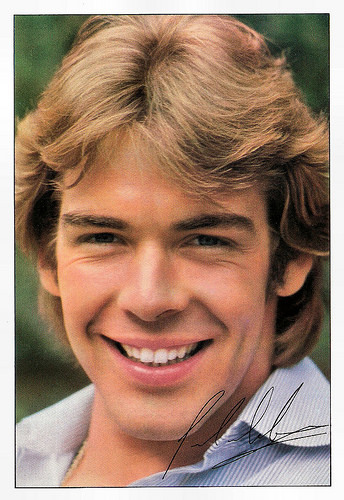
German autograph card by Bravo, 1979.

German autograph card by Möbelhöhn. Caption: Ein herzliches Dankeschön für ihren Besuch am 25. September 1988 bei Möbelhöhn (A heartfelt thank you for your visit on 25 September 1988 at Möbelhöhn).
German Exorcist Rip-off
In the following years, Sascha Hehn also made non-sex films including a new version of Schloss Hubertus/Hubertus Castle (Harald Reinl, 1973) with Robert Hoffmann, and the German Exorcist Rip-off Magdalena – vom Teufel besessen/Beyond the Darkness (Walter Boos, 1974).
He also turned up in popular TV Krimi’s like Der Kommissar/The Commissioner (1975), Der Alte/The Old Fox (1979-1982) and in six episodes of Derrick (1979-1986) with Horst Tappert and Fritz Wepper .
In 1976 he played Pete Jarrett, a young man following his grandfather (Andrew Kier) throughout ‘down under’ in the 13-part Australian-German TV series The Outsiders. Later, he had another role in an international production as Baron Gottfried von Cramm opposite Farrah Fawcett in Poor Little Rich Girl – The Barbara Hutton Story (Charles Jarrott, 1987).
Hehn also played theatre. In 1972, he went on tour with O.W. Fischer in the comedy The Glass of Water by Eugène Scribe. In 1980 he made his debut at the Salzburg Festival as Orlando in William Shakespeare's As you like it, as a partner of Barbara Sukowa. In an interview with the Süddeutsche Zeitung , he explained why he broke off his promising stage career: "Intendant Ernst Haeusserman wanted to get me to the Theater in der Josefstadt in Vienna, but I said: No, Professor, that's not my way. I want to earn money in commerce. That's the only excuse I'm allowing, he said."
So, Sascha Hehn became best known in Germany for two long-running TV series. In Das Traumschiff/The Dreamboat (1981-1991), he played chief steward Viktor and in Schwarzwaldklinik/The Black Forest Clinic (1985-1989), he played doctor Udo Brinkmann opposite Klausjürgen Wussow. In 2014, he succeeded Siegfried Rauch in Das Traumschiff as captain Victor Burger. The series still continues. In the same role, he also appears in the spin-off Kreuzfahrt ins Glück/Cruise to happiness (2014-2018).
Hehn also dubbed several international films. He gave his voice to Shrek for the German versions of the films Shrek (Andrew Adamson, Vicky Jenson, 2001), Shrek 2 (Andrew Adamson, Kelly Asbury, 2004), Shrek the Third (Chris Miller, Raman Hui, 2007) and Shrek Forever After (Mike Mitchell, 2010).
Sascha Hehn lives with his girlfriend in Mittergars, a small village in Bavaria.

German autograph card.
Who the f--k is Sascha Hehn? Source: Der Batz (YouTube). Sorry, no subtitles.
German trailer for Shrek Forever After (2010). Source: xtreamproductionz (YouTube).
Sources: Malte Herwig (Süddeutsche Zeitung - German), Wikipedia (English and German), and .

German autograph card by Honda. Photo: Gabowicz, München. Publicity still for the TV series Das Traumschiff/The Dreamboat (1981-1991).

German autograph card by Karstadt. Caption: Sascha Hehn trägt Globetrotter von KARSTADT.
Film debut at five
Alexander Josef Alberto ‘Sascha’ Hehn was born in 1954 in Munich. He is one of the four sons of film actor Albert Hehn from his fourth marriage to Gardy Artinger, a former beauty-queen and assistant director.
After the divorce of his parents, he lived with his mother in the Munich suburb of Grünwald. At the age of five he made his film debut in the Heimatfilm Hubertusjagd/Hubertus Castle (Hermann Kugelstadt, 1959) starring Wolf Albach-Retty and Angelika Meissner in her final role.
More film roles for Hehn followed soon. He had parts in the melodrama Ein Student ging vorbei/A student passed by (Werner Klingler, 1960) with Luise Ullrich , and the Schlager and Heimat film Drei weiße Birken/Three White Birches (Hans Albin, 1961), starring Erika Remberg . As a pupil, he was so busy with his acting career that he left school before he reached the middle school.
During the 1960s he could be seen in many TV films, such as Der doppelte Nikolaus/The Double Nicholas (Rainer Erler, 1964), and the TV series Alarm in den Bergen/Alarm in the mountains (1965) with Armin Dahlen.
In 1971, Hehn returned to the cinema in the softsex film Schülerreport/Fresh, Young and Sexy (Eberhard Schröder, 1971), based on the schedule of the Schulmädchen-Report genre which was very successful in the early 1970s.
In the following years, the handsome teenager starred in a dozen German sexploitation films with such titles as Mädchen beim Frauenarzt/Girls at the Gynecologist (Ernst Hofbauer, 1971), Die Klosterschülerinnen/Sex Life in a Convent (Eberhard Schröder, 1972), and Junge Mädchen mögen’s heiß, Hausfrauen noch heißer/Crackajacks (Eberhard Schröder, 1973) with Birgit Bergen .
To avoid military service, Hehn falsely announced his first residence in West Berlin and later he had to serve a five-week prison sentence. In 1982 he was a soldier for several months with the mountain hunters in Landsberg am Lech.

German autograph card by Bravo, 1979.

German autograph card by Möbelhöhn. Caption: Ein herzliches Dankeschön für ihren Besuch am 25. September 1988 bei Möbelhöhn (A heartfelt thank you for your visit on 25 September 1988 at Möbelhöhn).
German Exorcist Rip-off
In the following years, Sascha Hehn also made non-sex films including a new version of Schloss Hubertus/Hubertus Castle (Harald Reinl, 1973) with Robert Hoffmann, and the German Exorcist Rip-off Magdalena – vom Teufel besessen/Beyond the Darkness (Walter Boos, 1974).
He also turned up in popular TV Krimi’s like Der Kommissar/The Commissioner (1975), Der Alte/The Old Fox (1979-1982) and in six episodes of Derrick (1979-1986) with Horst Tappert and Fritz Wepper .
In 1976 he played Pete Jarrett, a young man following his grandfather (Andrew Kier) throughout ‘down under’ in the 13-part Australian-German TV series The Outsiders. Later, he had another role in an international production as Baron Gottfried von Cramm opposite Farrah Fawcett in Poor Little Rich Girl – The Barbara Hutton Story (Charles Jarrott, 1987).
Hehn also played theatre. In 1972, he went on tour with O.W. Fischer in the comedy The Glass of Water by Eugène Scribe. In 1980 he made his debut at the Salzburg Festival as Orlando in William Shakespeare's As you like it, as a partner of Barbara Sukowa. In an interview with the Süddeutsche Zeitung , he explained why he broke off his promising stage career: "Intendant Ernst Haeusserman wanted to get me to the Theater in der Josefstadt in Vienna, but I said: No, Professor, that's not my way. I want to earn money in commerce. That's the only excuse I'm allowing, he said."
So, Sascha Hehn became best known in Germany for two long-running TV series. In Das Traumschiff/The Dreamboat (1981-1991), he played chief steward Viktor and in Schwarzwaldklinik/The Black Forest Clinic (1985-1989), he played doctor Udo Brinkmann opposite Klausjürgen Wussow. In 2014, he succeeded Siegfried Rauch in Das Traumschiff as captain Victor Burger. The series still continues. In the same role, he also appears in the spin-off Kreuzfahrt ins Glück/Cruise to happiness (2014-2018).
Hehn also dubbed several international films. He gave his voice to Shrek for the German versions of the films Shrek (Andrew Adamson, Vicky Jenson, 2001), Shrek 2 (Andrew Adamson, Kelly Asbury, 2004), Shrek the Third (Chris Miller, Raman Hui, 2007) and Shrek Forever After (Mike Mitchell, 2010).
Sascha Hehn lives with his girlfriend in Mittergars, a small village in Bavaria.

German autograph card.
Who the f--k is Sascha Hehn? Source: Der Batz (YouTube). Sorry, no subtitles.
German trailer for Shrek Forever After (2010). Source: xtreamproductionz (YouTube).
Sources: Malte Herwig (Süddeutsche Zeitung - German), Wikipedia (English and German), and .
Published on August 02, 2018 22:00
August 1, 2018
Struensee / Die Liebe einer Königin (1923)
The German silent film Struensee/Die Liebe einer Königin (Ludwig Wolff, 1923) deals with the historical affair between the German court physician Johann Friedrich Struensee and the Swedish Queen Caroline Mathilde. The famous lovers were played by Harry Liedtke and Henny Porten.
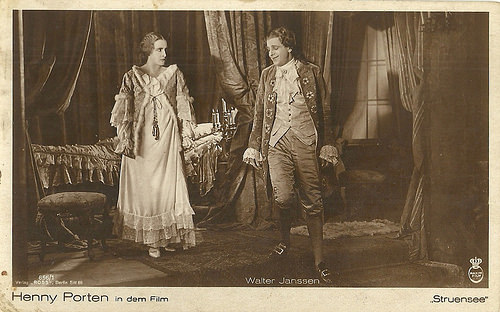
German postcard by Ross Verlag, no. 656/1. Photo: Maxim Film. Henny Porten and Walter Janssen in Struensee/Die Liebe einer Königin (Ludwig Wolff, 1923).
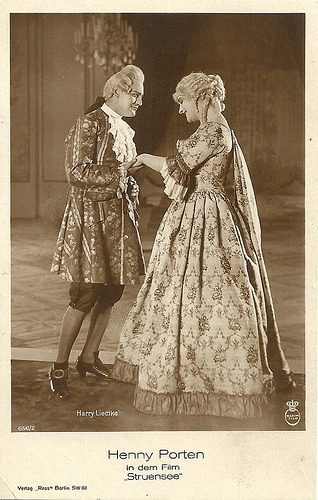
German postcard by Ross Verlag, no. 656/2. Photo: Maxim Film. Harry Liedtke and Henny Porten in Struensee/Die Liebe einer Königin (Ludwig Wolff, 1923).
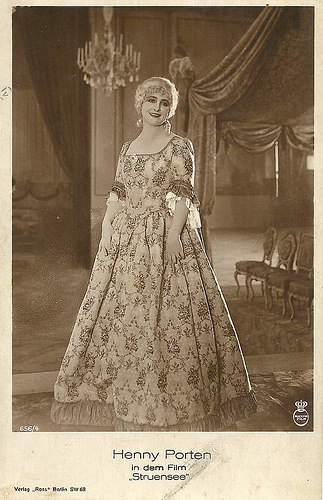
German postcard by Ross Verlag, no. 656/4. Photo: Maxim Film. Henny Porten in Struensee/Die Liebe einer Königin (Ludwig Wolff, 1923).
Forced pregnancy, homesickness and insanity
In 1766, 15-year-old Princess Caroline Mathilde ( Henny Porten ), youngest sister of King George III of England, is forced to marry her cousin, the notoriously insane King Christian VII of Denmark (Walter Janssen).
The Queen suffers from a forced pregnancy (she has a son with Christian), homesickness and the insanity of her husband. Gradually Caroline Mathilde falls in love with Johann Friedrich Struensee ( Harry Liedtke ), the smart new personal physician and counsellor of Christian.
She seduces him and gives herself the right to live her passion with the commoner. She even has an illegitimate daughter with him, Princess Louise Augusta, officially a daughter of Christian.
Struensee becomes de facto ruler of the kingdom and inspired by the Enlightenment he issues all kinds of reforms. Both are yet blind for the powers behind the screens. Christian VII at first tolerates the relationship of Caroline and Struensee, but acts when the enemy clique in court, led by the Queen-Dowager (Olga Limburg), accuses Struensee and the Queen of high treason.
Struensee is killed, while the queen's children are taken away from her and raised by her enemies. She herself is exiled to Castle Celle near Hannover, where, three years after, she dies of scarlet fever.
Struensee/Die Liebe einer Königin (1923) was written and directed by Ludwig Wolff and produced by Maxim Galitzenstein for his Maxim Film studio. Their film premiered in Berlin on 14 September 1923.
Several novels and stage plays were written about the Struensee affair. It was also at the heart of Per Olov Enquist's popular novel Livläkarens besök (The Visit of the Royal Physician, 1999). Irony has it that many a European royal house has lineage with Struensee through his daughter, Princess Louise Augusta.
There were several film adaptations of the historical affair. In 2012 it was again filmed as En kongelig affære/A Royal Affair by Nikolaj Arcel, starring Mads Mikkelsen as Struensee, Alicia Vikander as the Queen and Mikkel Følsgaard as the King. The film had nominations for both the Academy Award and the Golden Globe for Best Foreign Film. At the Berlin Film Festival, Mikkel Følsgaard won the Silver Bear for Best Actor.
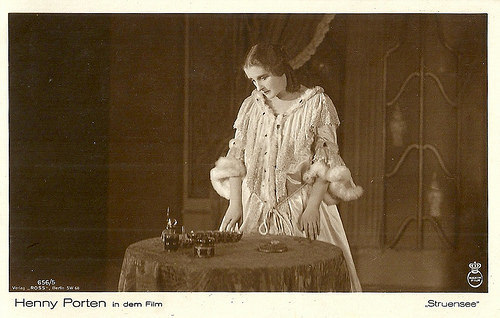
German postcard by Ross Verlag, no. 656/5. Photo: Maxim Film. Henny Porten in Struensee/Die Liebe einer Königin (Ludwig Wolff, 1923).
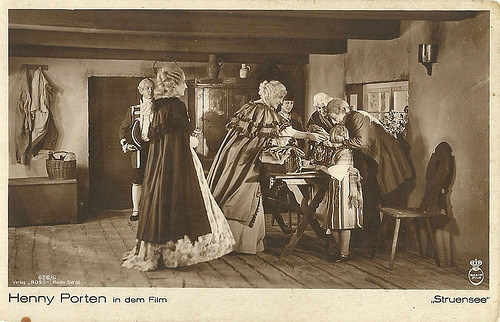
German postcard by Ross Verlag, no. 656/6. Photo: Maxim Film. Henny Porten in Struensee/Die Liebe einer Königin (Ludwig Wolff, 1923).
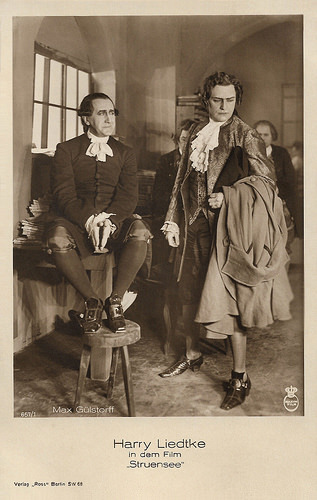
German postcard by Ross Verlag, no. 657/1. Photo: Maxim Film. Publicity still of Harry Liedtke and Max Gülstorff in Struensee/Die Liebe einer Königin (Ludwig Wolff, 1923).
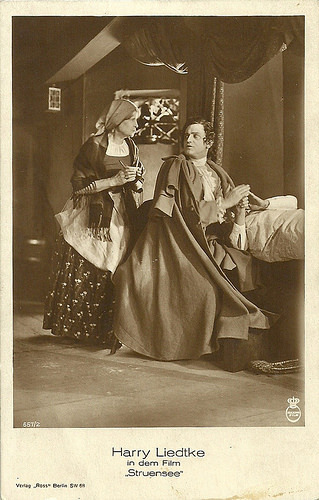
German postcard by Ross Verlag, no. 657/2. Photo: Maxim Film. Harry Liedtke in Struensee/Die Liebe einer Königin (Ludwig Wolff, 1923).
Sources: Wikipedia, Filmportal.de and IMDb.

German postcard by Ross Verlag, no. 656/1. Photo: Maxim Film. Henny Porten and Walter Janssen in Struensee/Die Liebe einer Königin (Ludwig Wolff, 1923).

German postcard by Ross Verlag, no. 656/2. Photo: Maxim Film. Harry Liedtke and Henny Porten in Struensee/Die Liebe einer Königin (Ludwig Wolff, 1923).

German postcard by Ross Verlag, no. 656/4. Photo: Maxim Film. Henny Porten in Struensee/Die Liebe einer Königin (Ludwig Wolff, 1923).
Forced pregnancy, homesickness and insanity
In 1766, 15-year-old Princess Caroline Mathilde ( Henny Porten ), youngest sister of King George III of England, is forced to marry her cousin, the notoriously insane King Christian VII of Denmark (Walter Janssen).
The Queen suffers from a forced pregnancy (she has a son with Christian), homesickness and the insanity of her husband. Gradually Caroline Mathilde falls in love with Johann Friedrich Struensee ( Harry Liedtke ), the smart new personal physician and counsellor of Christian.
She seduces him and gives herself the right to live her passion with the commoner. She even has an illegitimate daughter with him, Princess Louise Augusta, officially a daughter of Christian.
Struensee becomes de facto ruler of the kingdom and inspired by the Enlightenment he issues all kinds of reforms. Both are yet blind for the powers behind the screens. Christian VII at first tolerates the relationship of Caroline and Struensee, but acts when the enemy clique in court, led by the Queen-Dowager (Olga Limburg), accuses Struensee and the Queen of high treason.
Struensee is killed, while the queen's children are taken away from her and raised by her enemies. She herself is exiled to Castle Celle near Hannover, where, three years after, she dies of scarlet fever.
Struensee/Die Liebe einer Königin (1923) was written and directed by Ludwig Wolff and produced by Maxim Galitzenstein for his Maxim Film studio. Their film premiered in Berlin on 14 September 1923.
Several novels and stage plays were written about the Struensee affair. It was also at the heart of Per Olov Enquist's popular novel Livläkarens besök (The Visit of the Royal Physician, 1999). Irony has it that many a European royal house has lineage with Struensee through his daughter, Princess Louise Augusta.
There were several film adaptations of the historical affair. In 2012 it was again filmed as En kongelig affære/A Royal Affair by Nikolaj Arcel, starring Mads Mikkelsen as Struensee, Alicia Vikander as the Queen and Mikkel Følsgaard as the King. The film had nominations for both the Academy Award and the Golden Globe for Best Foreign Film. At the Berlin Film Festival, Mikkel Følsgaard won the Silver Bear for Best Actor.

German postcard by Ross Verlag, no. 656/5. Photo: Maxim Film. Henny Porten in Struensee/Die Liebe einer Königin (Ludwig Wolff, 1923).

German postcard by Ross Verlag, no. 656/6. Photo: Maxim Film. Henny Porten in Struensee/Die Liebe einer Königin (Ludwig Wolff, 1923).

German postcard by Ross Verlag, no. 657/1. Photo: Maxim Film. Publicity still of Harry Liedtke and Max Gülstorff in Struensee/Die Liebe einer Königin (Ludwig Wolff, 1923).

German postcard by Ross Verlag, no. 657/2. Photo: Maxim Film. Harry Liedtke in Struensee/Die Liebe einer Königin (Ludwig Wolff, 1923).
Sources: Wikipedia, Filmportal.de and IMDb.
Published on August 01, 2018 22:00
July 31, 2018
Louis Jouvet
Louis Jouvet (1887-1951) was one of the most influential personalities of the 20th century theatre. He is almost forgotten now, but Jouvet used to be a living glory of the French stage. He made a huge impact as both a stage director and an actor. His character, his eagle-like profile and his unique way of speaking made him also an unforgettable film star who appeared in some of the masterpieces of the ‘poetical realism’, the Golden Age of the French cinema.
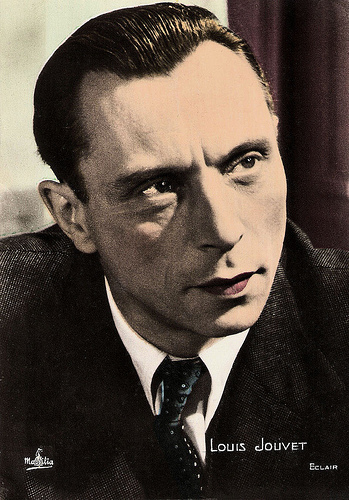
French postcard by Massilia. Photo: Eclair.
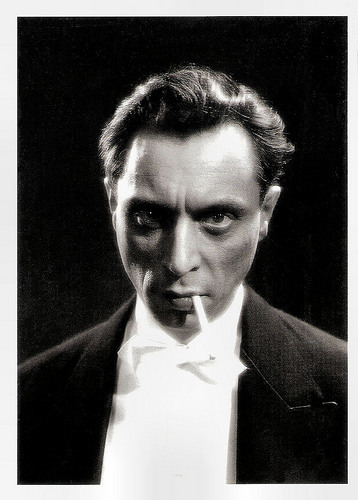
French postcard in the collection Magie Noire by Editions Hazan, Paris, 1990, no. 6218. Photo: publicity still for Les bas-fonds/Underground (Jean Renoir, 1936).
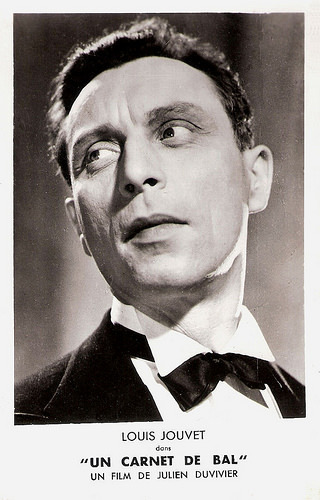
French postcard. Photo: publicity still for Un carnet de bal/Life Dances On (Julien Duvivier, 1937).
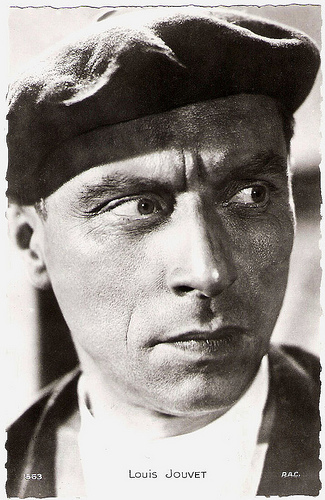
French postcard by Edit. Chantal, Rueil (S.-O.). Photo: R.A.C. Publicity still for Ramuntcho (René Barberis, 1938). Sent by mail in 1954.
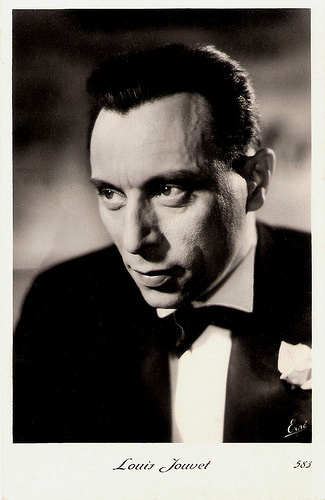
French postcard by Erpé, no. 583.
A staccato, syncopated diction
Jules Eugène Louis Jouvet was born in Crozon, Bretagne in 1887 in a devoutly catholic family. His father, from Brive, was an engineer, his mother Eugénie was from the Ardennes. When he was two years old, young Louis was sent to live with his grandmother Marie, in Belleville-sur-Bar in Ardennes, until 1894. Louis loved and admired his grandmother, and he would always remember this period as one of the happiest in his life.
At school, Louis was a quiet, reserved child spending his time working or dreaming. His teacher tried to make him lose his diction problems: he stammered and had great difficulty pronouncing the s. Later at the Notre-Dame College, where Chanoine Morigny was leading the theatre group with passion and harsh discipline, Louis became so preoccupied with his new passion for the theatre, that he decided to make it his career.
When Louis was 14, his father was crushed under rocks while he was overseeing the digging of a tunnel. After this tragedy, Louis left with his mother and two brothers to live with an uncle in Rethel in the Ardennes. Louis's uncle was a pharmacist, and his family urged him to make this his profession. From 1904, Louis studied pharmacy in Paris, but he spent all his spare time in the theatres.
His first job was as a pharmacy assistant, but he still longed to be an actor. Louis auditioned for the Conservatoire National Superieur d'Art Dramatique de Paris but he was rejected three times. He was reproached for his bad diction and his physical appearance. Jouvet was wounded by these failures, but managed to be admitted as auditor in Leloir's class at the Conservatoire in 1908. That's where he learned to better control his diction.
In 1908 Jouvet started to work for a theatre company as an administrator, later as a set dresser, and as an assistant. He approached actor Léon Noël after a performance and enrolled in his acting class, where he remained until 1910. Léon Noël was hard on his pupil, but Jouvet loved and respected him. In 1910 he finally made his stage debut in a production of The Brothers Karamazov. He also fell in love with a young Danish woman, Else Collin. In 1912 they married in Copenhagen and the couple would have three children, among them the later actress Lisa Jouvet.
In 1913, Jacques Copeau engaged him as a director for his Théâtre du Vieux-Colombier. This meant the turning point in his career. For a while, he was better known for his lighting design than for his acting (he even designed a new kind of lamp, named the jouvet). That year he also played a minor role in the film Shylock (Henri Desfontaines, 1913), starring Harry Baur, but his next film role would follow nearly two decades later.
Soon, critics and public alike took notice of Louis Jouvet's great acting talent in memorable productions of Molière's La Jalousie du Barbouillé, and William Shakespeare's Twelfth Night. He masked his speaking problems with a staccato, syncopated diction which made him instantly famous.
From 1919 till 1921 he worked in New York, appearing with his troupe in a repertory of productions that received much acclaim. In 1922, he broke with Jacques Copeau, and started his career as a stage director. He founded his own theatre company at the Théâtre des Champs-Élysées. There, he had his first great success with Knock ou le triomphe de la médecine (1923) by Jules Romains, which he played 1500 times.
In 1928, he met author Jean Giraudoux of whom he would go on to direct several plays. In 1934 he also became a teacher of acting technique and theatrical history at the Conservatoire de Paris. From 1935 on, he managed the Théâtre de l'Athénée in the centre of Paris, where the first performances took place of Giraudoux’ La guerre de Troie n'aura pas lieu (Tiger at the Gates) (1935), and Ondine (1939).
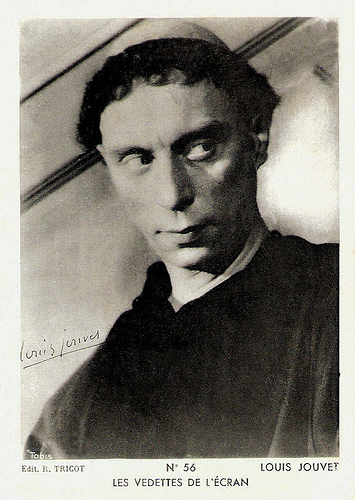
French collectors card in the series Les Vedettes de L'écran by Edit. R. Tricot, offered by Becco Douceurs, no. 56. Photo: Tobis. Publicity still for La Kermesse héroïque/Carnival in Flanders (Jacques Feyder, 1935).
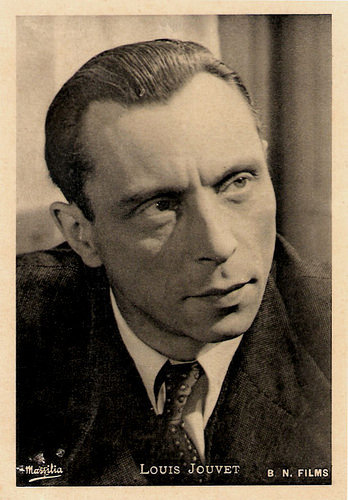
French card by Massilia. Photo: B.N. Films. Publicity still for L'Alibi /The Alibi (Pierre Chenal, 1937).
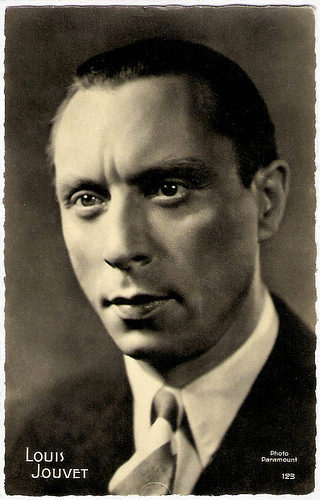
French postcard by Editions O.P., Paris, no. 123. Photo: Paramount.
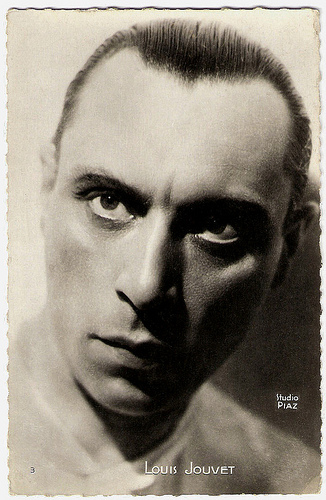
French postcard by Editions P.I., Paris, no. 3. Photo: Studio Piaz.
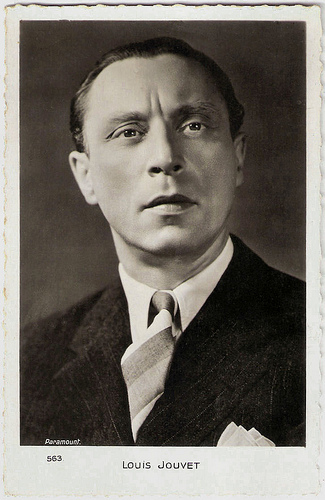
French postcard by Collection Chantal, Paris, no. 563. Photo: Paramount.
Undisputed classics
Louis Jouvet would dedicate his life to the theatre. He is reputed to have said that he acted in films only so that he could raise the money to finance his stage work. Yet his 32 films, many of which are now undisputed classics of the French cinema, provide an enduring record of the talent of this great actor.
Jouvet made his first significant film appearance in the comedy Topaze (Louis Gasnier, 1932), an adaptation of a play written by Marcel Pagnol, whom Jouvet admired greatly. He played an earnest schoolteacher who teaches his pupils that honesty is the best policy eventually changes his mind when confronted with the corruption of the business world. The film was made at the Joinville Studios in Paris by the French subsidiary of Paramount Pictures.
The following year, Jouvet enjoyed his first commercial film success with the adaptation of his stage hit Knock ou le triomphe de la médecine/Knock (Louis Jouvet, Roger Goupillières, 1933). In Knock, he cast a young actress in a small role, Madeleine Ozeray . They would remain together for the next ten years, both on stage and in life.
Soon more film successes followed, such as the historical romantic comedy La kermesse héroïque/Carnival in Flanders (Jacques Feyder, 1935) with Françoise Rosay , and the drama Un Carnet de bal/Life Dances On (Julien Duvivier, 1937) starring Marie Bell , but his subtle, forceful, witty performances redeemed also some poor films.
His finest performances were in some of the masterpieces of the poetic realism cinema: the black comic farce Drôle de drame/Bizarre, Bizarre (Marcel Carné, 1936) in which he played the Bishop of Bedford opposite Michel Simon , the drama Hotel du Nord (Marcel Carné, 1938) with Annabella and Arletty , and the drama La fin du jour/The End of a Day (Julien Duvivier, 1939) with Jean Gabin .
Jouvet also appeared in two films by Jean Renoir. In the romantic crime drama Les bas-fonds/The Lower Depths (1936) he played a bankrupt baron who makes friends with a charismatic thief (Jean Gabin) and comes to live in the thief's slum. La Marseillaise/The Marseillaise (1938) is a news-reel like film about early part of the French Revolution, shown from the eyes of individual people, including Jouvet as a district attorney.
In 1941, having experienced serious problems with the censorship of the German occupier, he took his repertory company for a tour of South America. Only after the war, Jouvet returned to France. Again as the director of the théâtre de l’Athénée, he created with Giraudoux La Folle de Chaillot (The Madwoman of Chaillot) (1945). He also helped the new theatre figures like André Barsacq, Jean-Louis Barrault and Jean Vilar.
His comeback film after the war was the atmospheric thriller Quai des Orfèvres/Quay of the Goldsmiths (Henri-Georges Clouzot, 1947) with Suzy Delair . Jouvet had become good friends with director Clouzot before World War II. Jouvet accepted the part of Inspector Antoine on the condition that a flexible shooting schedule would be allowed and that Clouzot would cast some of Jouvet's troupe members in the film, including Charles Dullin as Brignon, the murder victim. In 1947, Quai des Orfèvres was the fourth most popular film in France, drawing 5.5 million spectators.
In 1950, Louis Jouvet received the Légion d'honneur. Just before his death he appeared in a new film adaptation of his old success, Knock ou le triomphe de la médecine: Knock/Dr. Knock (Guy Lefranc, 1951). It also featured Jean Brochard, Pierre Renoir , Jean Carmet and an uncredited appearance by Louis de Funès .
At the age of 63, Louis Jouvet died of a heart attack in 1951 in Paris. He was buried in the Montmartre Cemetery. Jouvet was married twice; to Else Collin and to Madeleine Ozeray . The Athénée theatre now includes his name as an homage: Athénée Théâtre Louis-Jouvet.
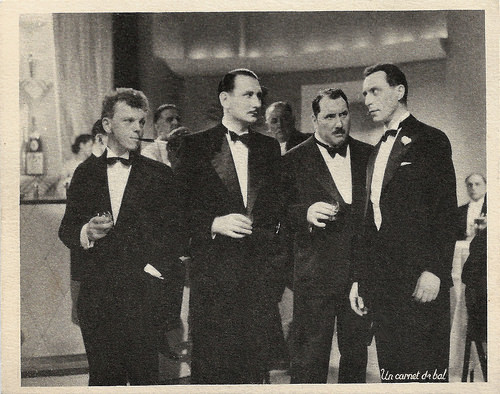
French collectors card by Dist. Les Films Vog. Photo: publicity still for Un carnet de bal/Dance Program (Julien Duvivier, 1937) with Louis Jouvet at right.
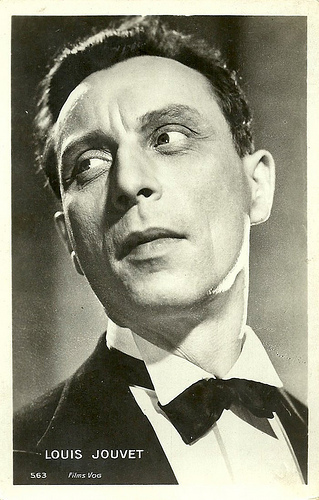
French postcard by Editions Chantal, Paris, no. 563. Photo: Dist. Les Films Vog. Publicity still for Un carnet de bal (Julien Duvivier, 1937).
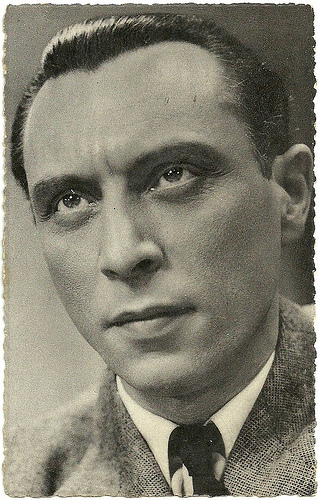
Belgian postcard, offered by Kwatta chocolade. Photo: Dist. Filmsonor / N. Els, Bromurite.
Scene from Drôle de drame/Bizarre, Bizarre (1936) with Jouvet and Michel Simon . Source: Julien Morvan (YouTube). Sorry, no subtitles.
French trailer for La fin du jour/The End of a Day (Julien Duvivier, 1939). Source: Pathe (YouTube). Sorry, no subtitles.
Sources: James Travers (Films de France), (IMDb), Geocities, AllMovie, Wikipedia, and .

French postcard by Massilia. Photo: Eclair.

French postcard in the collection Magie Noire by Editions Hazan, Paris, 1990, no. 6218. Photo: publicity still for Les bas-fonds/Underground (Jean Renoir, 1936).

French postcard. Photo: publicity still for Un carnet de bal/Life Dances On (Julien Duvivier, 1937).

French postcard by Edit. Chantal, Rueil (S.-O.). Photo: R.A.C. Publicity still for Ramuntcho (René Barberis, 1938). Sent by mail in 1954.

French postcard by Erpé, no. 583.
A staccato, syncopated diction
Jules Eugène Louis Jouvet was born in Crozon, Bretagne in 1887 in a devoutly catholic family. His father, from Brive, was an engineer, his mother Eugénie was from the Ardennes. When he was two years old, young Louis was sent to live with his grandmother Marie, in Belleville-sur-Bar in Ardennes, until 1894. Louis loved and admired his grandmother, and he would always remember this period as one of the happiest in his life.
At school, Louis was a quiet, reserved child spending his time working or dreaming. His teacher tried to make him lose his diction problems: he stammered and had great difficulty pronouncing the s. Later at the Notre-Dame College, where Chanoine Morigny was leading the theatre group with passion and harsh discipline, Louis became so preoccupied with his new passion for the theatre, that he decided to make it his career.
When Louis was 14, his father was crushed under rocks while he was overseeing the digging of a tunnel. After this tragedy, Louis left with his mother and two brothers to live with an uncle in Rethel in the Ardennes. Louis's uncle was a pharmacist, and his family urged him to make this his profession. From 1904, Louis studied pharmacy in Paris, but he spent all his spare time in the theatres.
His first job was as a pharmacy assistant, but he still longed to be an actor. Louis auditioned for the Conservatoire National Superieur d'Art Dramatique de Paris but he was rejected three times. He was reproached for his bad diction and his physical appearance. Jouvet was wounded by these failures, but managed to be admitted as auditor in Leloir's class at the Conservatoire in 1908. That's where he learned to better control his diction.
In 1908 Jouvet started to work for a theatre company as an administrator, later as a set dresser, and as an assistant. He approached actor Léon Noël after a performance and enrolled in his acting class, where he remained until 1910. Léon Noël was hard on his pupil, but Jouvet loved and respected him. In 1910 he finally made his stage debut in a production of The Brothers Karamazov. He also fell in love with a young Danish woman, Else Collin. In 1912 they married in Copenhagen and the couple would have three children, among them the later actress Lisa Jouvet.
In 1913, Jacques Copeau engaged him as a director for his Théâtre du Vieux-Colombier. This meant the turning point in his career. For a while, he was better known for his lighting design than for his acting (he even designed a new kind of lamp, named the jouvet). That year he also played a minor role in the film Shylock (Henri Desfontaines, 1913), starring Harry Baur, but his next film role would follow nearly two decades later.
Soon, critics and public alike took notice of Louis Jouvet's great acting talent in memorable productions of Molière's La Jalousie du Barbouillé, and William Shakespeare's Twelfth Night. He masked his speaking problems with a staccato, syncopated diction which made him instantly famous.
From 1919 till 1921 he worked in New York, appearing with his troupe in a repertory of productions that received much acclaim. In 1922, he broke with Jacques Copeau, and started his career as a stage director. He founded his own theatre company at the Théâtre des Champs-Élysées. There, he had his first great success with Knock ou le triomphe de la médecine (1923) by Jules Romains, which he played 1500 times.
In 1928, he met author Jean Giraudoux of whom he would go on to direct several plays. In 1934 he also became a teacher of acting technique and theatrical history at the Conservatoire de Paris. From 1935 on, he managed the Théâtre de l'Athénée in the centre of Paris, where the first performances took place of Giraudoux’ La guerre de Troie n'aura pas lieu (Tiger at the Gates) (1935), and Ondine (1939).

French collectors card in the series Les Vedettes de L'écran by Edit. R. Tricot, offered by Becco Douceurs, no. 56. Photo: Tobis. Publicity still for La Kermesse héroïque/Carnival in Flanders (Jacques Feyder, 1935).

French card by Massilia. Photo: B.N. Films. Publicity still for L'Alibi /The Alibi (Pierre Chenal, 1937).

French postcard by Editions O.P., Paris, no. 123. Photo: Paramount.

French postcard by Editions P.I., Paris, no. 3. Photo: Studio Piaz.

French postcard by Collection Chantal, Paris, no. 563. Photo: Paramount.
Undisputed classics
Louis Jouvet would dedicate his life to the theatre. He is reputed to have said that he acted in films only so that he could raise the money to finance his stage work. Yet his 32 films, many of which are now undisputed classics of the French cinema, provide an enduring record of the talent of this great actor.
Jouvet made his first significant film appearance in the comedy Topaze (Louis Gasnier, 1932), an adaptation of a play written by Marcel Pagnol, whom Jouvet admired greatly. He played an earnest schoolteacher who teaches his pupils that honesty is the best policy eventually changes his mind when confronted with the corruption of the business world. The film was made at the Joinville Studios in Paris by the French subsidiary of Paramount Pictures.
The following year, Jouvet enjoyed his first commercial film success with the adaptation of his stage hit Knock ou le triomphe de la médecine/Knock (Louis Jouvet, Roger Goupillières, 1933). In Knock, he cast a young actress in a small role, Madeleine Ozeray . They would remain together for the next ten years, both on stage and in life.
Soon more film successes followed, such as the historical romantic comedy La kermesse héroïque/Carnival in Flanders (Jacques Feyder, 1935) with Françoise Rosay , and the drama Un Carnet de bal/Life Dances On (Julien Duvivier, 1937) starring Marie Bell , but his subtle, forceful, witty performances redeemed also some poor films.
His finest performances were in some of the masterpieces of the poetic realism cinema: the black comic farce Drôle de drame/Bizarre, Bizarre (Marcel Carné, 1936) in which he played the Bishop of Bedford opposite Michel Simon , the drama Hotel du Nord (Marcel Carné, 1938) with Annabella and Arletty , and the drama La fin du jour/The End of a Day (Julien Duvivier, 1939) with Jean Gabin .
Jouvet also appeared in two films by Jean Renoir. In the romantic crime drama Les bas-fonds/The Lower Depths (1936) he played a bankrupt baron who makes friends with a charismatic thief (Jean Gabin) and comes to live in the thief's slum. La Marseillaise/The Marseillaise (1938) is a news-reel like film about early part of the French Revolution, shown from the eyes of individual people, including Jouvet as a district attorney.
In 1941, having experienced serious problems with the censorship of the German occupier, he took his repertory company for a tour of South America. Only after the war, Jouvet returned to France. Again as the director of the théâtre de l’Athénée, he created with Giraudoux La Folle de Chaillot (The Madwoman of Chaillot) (1945). He also helped the new theatre figures like André Barsacq, Jean-Louis Barrault and Jean Vilar.
His comeback film after the war was the atmospheric thriller Quai des Orfèvres/Quay of the Goldsmiths (Henri-Georges Clouzot, 1947) with Suzy Delair . Jouvet had become good friends with director Clouzot before World War II. Jouvet accepted the part of Inspector Antoine on the condition that a flexible shooting schedule would be allowed and that Clouzot would cast some of Jouvet's troupe members in the film, including Charles Dullin as Brignon, the murder victim. In 1947, Quai des Orfèvres was the fourth most popular film in France, drawing 5.5 million spectators.
In 1950, Louis Jouvet received the Légion d'honneur. Just before his death he appeared in a new film adaptation of his old success, Knock ou le triomphe de la médecine: Knock/Dr. Knock (Guy Lefranc, 1951). It also featured Jean Brochard, Pierre Renoir , Jean Carmet and an uncredited appearance by Louis de Funès .
At the age of 63, Louis Jouvet died of a heart attack in 1951 in Paris. He was buried in the Montmartre Cemetery. Jouvet was married twice; to Else Collin and to Madeleine Ozeray . The Athénée theatre now includes his name as an homage: Athénée Théâtre Louis-Jouvet.

French collectors card by Dist. Les Films Vog. Photo: publicity still for Un carnet de bal/Dance Program (Julien Duvivier, 1937) with Louis Jouvet at right.

French postcard by Editions Chantal, Paris, no. 563. Photo: Dist. Les Films Vog. Publicity still for Un carnet de bal (Julien Duvivier, 1937).

Belgian postcard, offered by Kwatta chocolade. Photo: Dist. Filmsonor / N. Els, Bromurite.
Scene from Drôle de drame/Bizarre, Bizarre (1936) with Jouvet and Michel Simon . Source: Julien Morvan (YouTube). Sorry, no subtitles.
French trailer for La fin du jour/The End of a Day (Julien Duvivier, 1939). Source: Pathe (YouTube). Sorry, no subtitles.
Sources: James Travers (Films de France), (IMDb), Geocities, AllMovie, Wikipedia, and .
Published on July 31, 2018 22:00
July 30, 2018
New Amit Benyovits acquisition: Clovis Star Chocolate Cards
In 2012, collector Amit Benyovits started our love for Massilia collectors cards. Last week he sent me scans of a new acquisition, a series of 50 'Premium' collectors cards from Belgium. The cards were produced for Chocolaterie Clovis in Pepinster, and while Belgium is a bilingual country, the texts on the flip sides of the cards are both in French (the language spoken in Wallonia) and in Dutch (spoken in Flanders). The cards were printed in Italy by Bromofoto in Milan, and the portrayed stars are all well known Hollywood movie actors. There are no dates on the cards, but Amit and I guess they were made in the late 1940s.
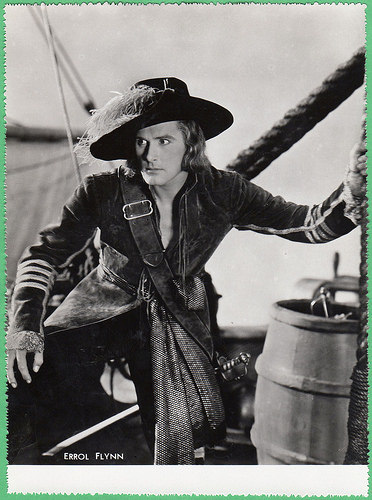
Errol Flynn . Belgian collectors card by Chocolaterie Clovis, Pepinster. Photo: publicity still for Captain Blood (Michael Curtiz, 1935). Collection: Amit Benyovits.
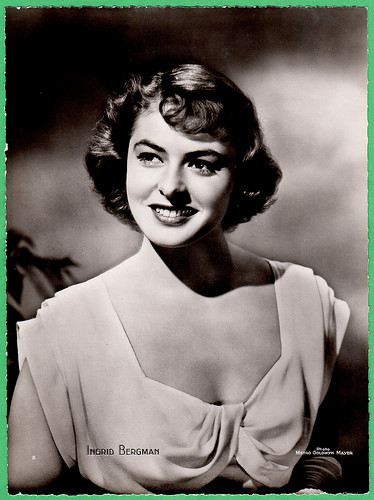
Ingrid Bergman . Belgian collectors card by Chocolaterie Clovis, Pepinster, no. 5. Photo: Metro Goldwyn Mayer. Collection: Amit Benyovits.
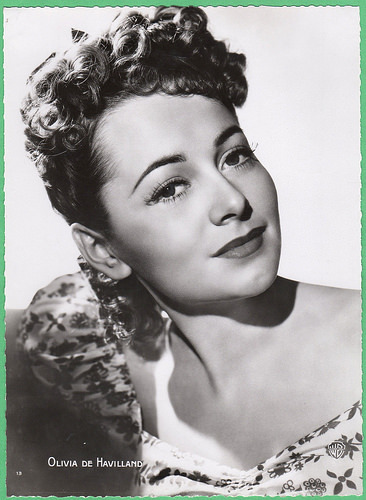
Olivia de Havilland. Belgian collectors card by Chocolaterie Clovis, Pepinster, no. 13. Photo: Warner Brothers. Collection: Amit Benyovits.
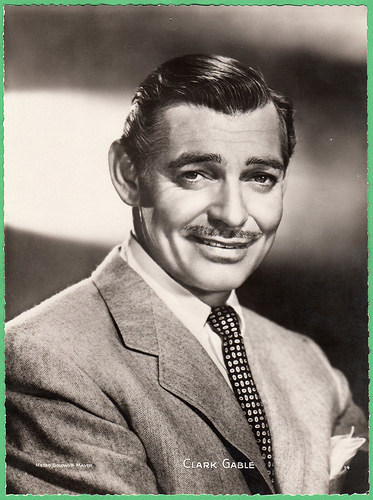
Clark Gable. Belgian collectors card by Chocolaterie Clovis, Pepinster, no. 14. Photo: Metro-Goldwyn-Mayer. Collection: Amit Benyovits.

Myrna Loy. Belgian collectors card by Chocolaterie Clovis, Pepinster, no. 25. Photo: Universal International. Collection: Amit Benyovits.
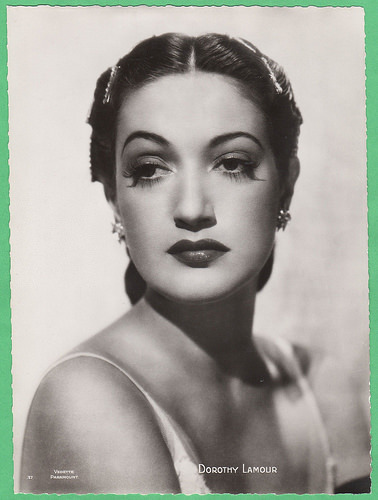
Dorothy Lamour. Belgian collectors card by Chocolaterie Clovis, Pepinster, no. 37. Photo: Paramount. Collection: Amit Benyovits.
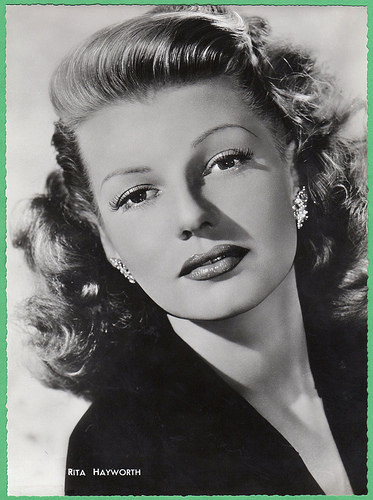
Rita Hayworth . Belgian collectors card by Chocolaterie Clovis, Pepinster. Collection: Amit Benyovits
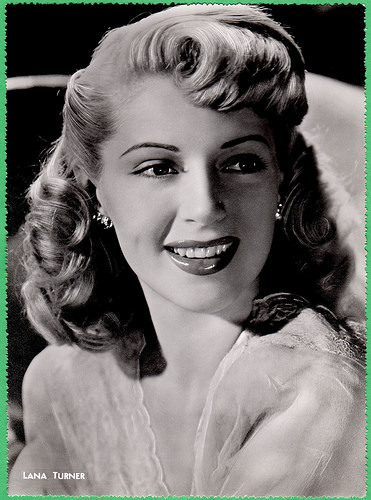
Lana Turner. Belgian collectors card by Chocolaterie Clovis, Pepinster. Collection: Amit Benyovits.
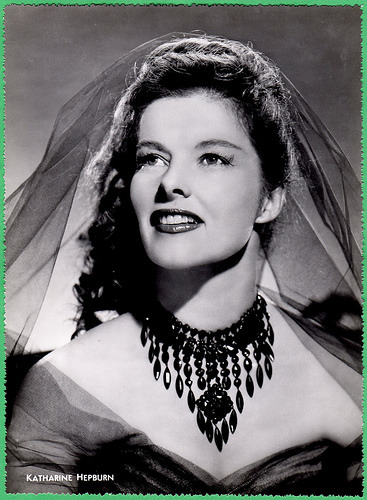
Katharine Hepburn. Belgian collectors card by Chocolaterie Clovis, Pepinster. Collection: Amit Benyovits.
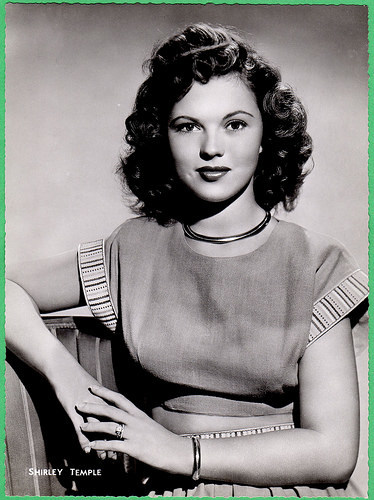
Shirley Temple. Belgian collectors card by Chocolaterie Clovis, Pepinster. Collection: Amit Benyovits.
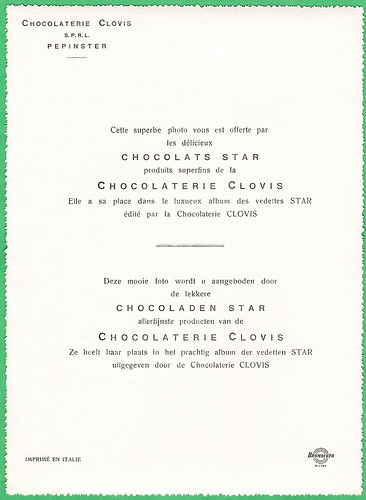
Flipside of Belgian collectors card by Chocolaterie Clovis, Pepinster. Collection: Amit Benyovits.
Show me your chocolate side, please
Belgium must be the no. 1 Chocolate country in the world. There are many little chocolate factories and their 'pralines' are delicious. The Belgians, but also foreign visitors, go to shop for them on Sundays in the countless confiseries of the country.
I had never heard of Chocolaterie Clovis before. French Wikipedia writes that the factory does not exist anymore. Clovis was founded in 1920 in Pepinster. The company ceased operations in 1966, following the destruction of the buildings by fire.
In the 1930s and 1940s, there must have been a close connection between chocolate and film stars. Directors prepared their female stars for their close-ups by saying: "Show me your chocolate side, please", as commemorated by Dutch film star Cissy van Bennekom in an old interview with Vrij Nederland magazine.
Other Belgian chocolate firms, like Kwatta , also published film star postcards and included them with their products. So, this beautiful series of film star cards is one of the few things that still remind us of Chocolaterie Clovis. A sweet reminder.
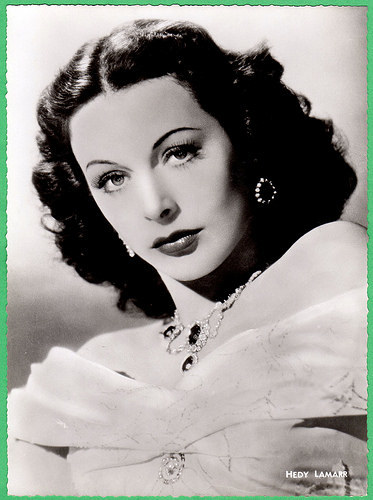
Hedy Lamarr . Belgian collectors card by Chocolaterie Clovis, Pepinster. Photo: Paramount. Collection: Amit Benyovits.
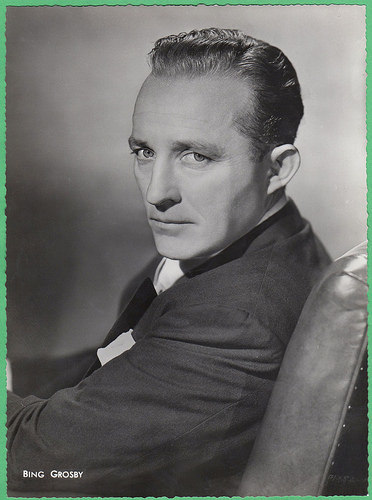
Bing Crosby. Belgian collectors card by Chocolaterie Clovis, Pepinster. Collection: Amit Benyovits.
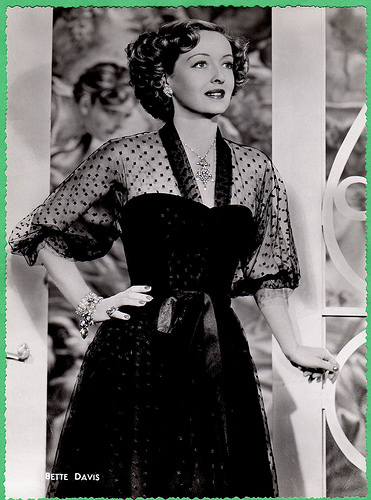
Bette Davis. Belgian collectors card by Chocolaterie Clovis, Pepinster. Collection: Amit Benyovits.
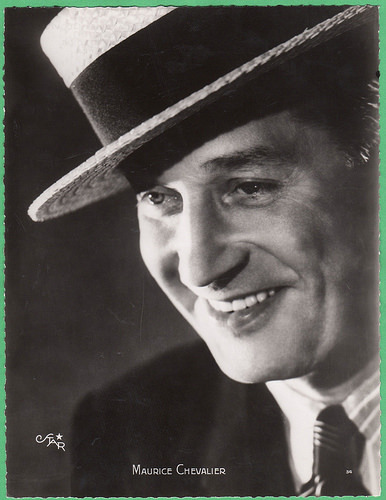
Maurice Chevalier . Belgian collectors card by Chocolaterie Clovis, Pepinster, no. 34. Photo: Star. Collection: Amit Benyovits.
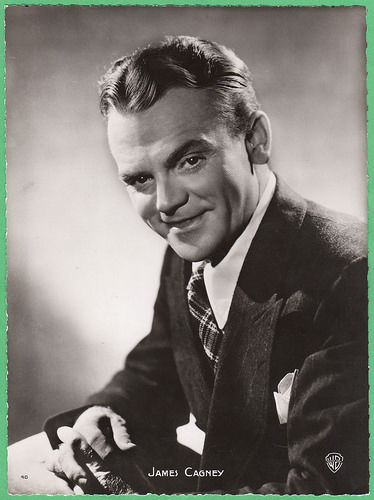
James Cagney. Belgian collectors card by Chocolaterie Clovis, Pepinster, no. 40. Photo: Warner Bros. Collection: Amit Benyovits.
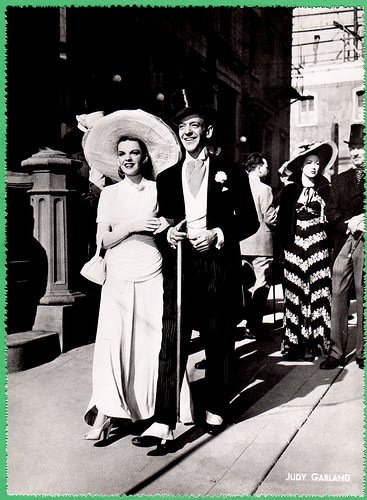
Judy Garland and Fred Astaire. Belgian collectors card by Chocolaterie Clovis, Pepinster. Photo: Metro Goldwyn Mayer. Publicity still for Easter Parade (Charles Walters, 1948). Collection: Amit Benyovits.
High grade and well made
The 50 Clovis photos came housed in a special album. Amit Benyovits sent me some pictures of the high grade and well made album, which you can see below. Amit: "The card stock is very thick and of very high quality pictures and paper."
In his mails to me, Amit also mentioned that the album size is 10 x 11 3/4" (25 x 30 cm) and the card size 6 1/2 x 8 7/8" (16,5 x 22,5 cm). Among the 50 cards there are at least 8 different backs but all with Clovis Pepinster either stamped or pre-printed on the backs. Sometimes the cards have the backs showing they were produced by a well known postcard publisher in Italy, Bromofoto in Milano (Milan).
Amit: "I'm dating these in the 1940s as some stars only began their careers during that time. It is mine and Cliff Aliperti's as well as Troy Kirk's opinion that these are what we call in North America 'Premium' photos. Premium photos are those that are acquired from the company. By redemption of something you had to mail in ...in Clovis' case probably a certain number of Clovis cards plus some cash too. We are just speculating and hope that you may be able to shed some light on how these were acquired by collectors."
My guess is that the cards were not sold, but were included as gifts in the Clovis Star chocolate boxes. Customers got probably hooked and must have lost their nice figures while collecting all these beautiful star cards.
The albums could be bought in the chocolate shops. Anyway that was - and still is - one of the traditions of collecting cards in the Netherlands. Another form of collecting is buying packages of cards in tobacco shops, like the famous Panini cards of soccer players and pop stars.
Clovis also made other series of collectors cards, for example a series with cyclists. Then and now, cycling is a very popular sports in Belgium.
I like Amit's Clovis star cards very much and only had two Clovis cards in my own collection. So Amit, thank you very much for sharing this new acquisition with us!
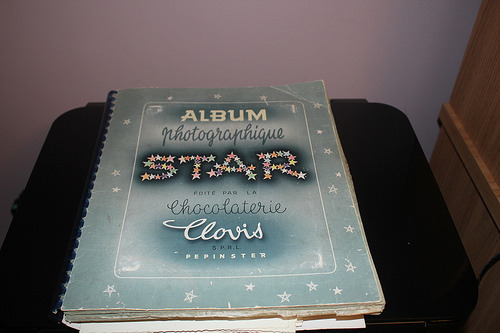
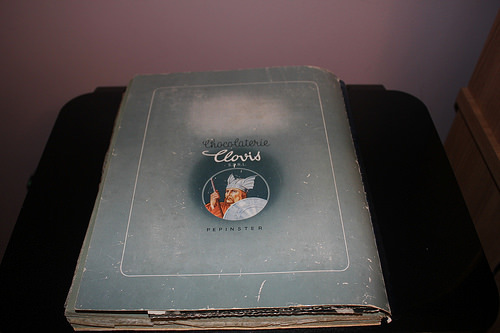
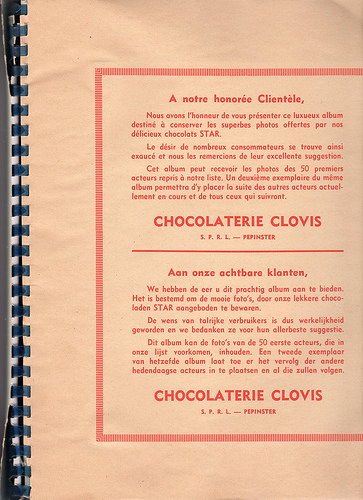
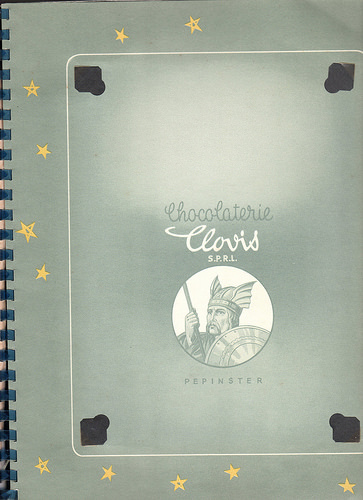
Album for Belgian Star collectors cards by Chocolaterie Clovis, Pepinster. Collection: Amit Benyovits.
Sources: Amit Benyovits and Wikipedia (French).

Errol Flynn . Belgian collectors card by Chocolaterie Clovis, Pepinster. Photo: publicity still for Captain Blood (Michael Curtiz, 1935). Collection: Amit Benyovits.

Ingrid Bergman . Belgian collectors card by Chocolaterie Clovis, Pepinster, no. 5. Photo: Metro Goldwyn Mayer. Collection: Amit Benyovits.

Olivia de Havilland. Belgian collectors card by Chocolaterie Clovis, Pepinster, no. 13. Photo: Warner Brothers. Collection: Amit Benyovits.

Clark Gable. Belgian collectors card by Chocolaterie Clovis, Pepinster, no. 14. Photo: Metro-Goldwyn-Mayer. Collection: Amit Benyovits.

Myrna Loy. Belgian collectors card by Chocolaterie Clovis, Pepinster, no. 25. Photo: Universal International. Collection: Amit Benyovits.

Dorothy Lamour. Belgian collectors card by Chocolaterie Clovis, Pepinster, no. 37. Photo: Paramount. Collection: Amit Benyovits.

Rita Hayworth . Belgian collectors card by Chocolaterie Clovis, Pepinster. Collection: Amit Benyovits

Lana Turner. Belgian collectors card by Chocolaterie Clovis, Pepinster. Collection: Amit Benyovits.

Katharine Hepburn. Belgian collectors card by Chocolaterie Clovis, Pepinster. Collection: Amit Benyovits.

Shirley Temple. Belgian collectors card by Chocolaterie Clovis, Pepinster. Collection: Amit Benyovits.

Flipside of Belgian collectors card by Chocolaterie Clovis, Pepinster. Collection: Amit Benyovits.
Show me your chocolate side, please
Belgium must be the no. 1 Chocolate country in the world. There are many little chocolate factories and their 'pralines' are delicious. The Belgians, but also foreign visitors, go to shop for them on Sundays in the countless confiseries of the country.
I had never heard of Chocolaterie Clovis before. French Wikipedia writes that the factory does not exist anymore. Clovis was founded in 1920 in Pepinster. The company ceased operations in 1966, following the destruction of the buildings by fire.
In the 1930s and 1940s, there must have been a close connection between chocolate and film stars. Directors prepared their female stars for their close-ups by saying: "Show me your chocolate side, please", as commemorated by Dutch film star Cissy van Bennekom in an old interview with Vrij Nederland magazine.
Other Belgian chocolate firms, like Kwatta , also published film star postcards and included them with their products. So, this beautiful series of film star cards is one of the few things that still remind us of Chocolaterie Clovis. A sweet reminder.

Hedy Lamarr . Belgian collectors card by Chocolaterie Clovis, Pepinster. Photo: Paramount. Collection: Amit Benyovits.

Bing Crosby. Belgian collectors card by Chocolaterie Clovis, Pepinster. Collection: Amit Benyovits.

Bette Davis. Belgian collectors card by Chocolaterie Clovis, Pepinster. Collection: Amit Benyovits.

Maurice Chevalier . Belgian collectors card by Chocolaterie Clovis, Pepinster, no. 34. Photo: Star. Collection: Amit Benyovits.

James Cagney. Belgian collectors card by Chocolaterie Clovis, Pepinster, no. 40. Photo: Warner Bros. Collection: Amit Benyovits.

Judy Garland and Fred Astaire. Belgian collectors card by Chocolaterie Clovis, Pepinster. Photo: Metro Goldwyn Mayer. Publicity still for Easter Parade (Charles Walters, 1948). Collection: Amit Benyovits.
High grade and well made
The 50 Clovis photos came housed in a special album. Amit Benyovits sent me some pictures of the high grade and well made album, which you can see below. Amit: "The card stock is very thick and of very high quality pictures and paper."
In his mails to me, Amit also mentioned that the album size is 10 x 11 3/4" (25 x 30 cm) and the card size 6 1/2 x 8 7/8" (16,5 x 22,5 cm). Among the 50 cards there are at least 8 different backs but all with Clovis Pepinster either stamped or pre-printed on the backs. Sometimes the cards have the backs showing they were produced by a well known postcard publisher in Italy, Bromofoto in Milano (Milan).
Amit: "I'm dating these in the 1940s as some stars only began their careers during that time. It is mine and Cliff Aliperti's as well as Troy Kirk's opinion that these are what we call in North America 'Premium' photos. Premium photos are those that are acquired from the company. By redemption of something you had to mail in ...in Clovis' case probably a certain number of Clovis cards plus some cash too. We are just speculating and hope that you may be able to shed some light on how these were acquired by collectors."
My guess is that the cards were not sold, but were included as gifts in the Clovis Star chocolate boxes. Customers got probably hooked and must have lost their nice figures while collecting all these beautiful star cards.
The albums could be bought in the chocolate shops. Anyway that was - and still is - one of the traditions of collecting cards in the Netherlands. Another form of collecting is buying packages of cards in tobacco shops, like the famous Panini cards of soccer players and pop stars.
Clovis also made other series of collectors cards, for example a series with cyclists. Then and now, cycling is a very popular sports in Belgium.
I like Amit's Clovis star cards very much and only had two Clovis cards in my own collection. So Amit, thank you very much for sharing this new acquisition with us!




Album for Belgian Star collectors cards by Chocolaterie Clovis, Pepinster. Collection: Amit Benyovits.
Sources: Amit Benyovits and Wikipedia (French).
Published on July 30, 2018 22:00
July 29, 2018
Szöke Szakáll
Cute, chubby-jowled Hungarian actor Szöke Szakáll (1883-1955) started his film career in the German and Austrian silent cinema. From 1940 on, he became known in Hollywood as character actor S.Z. Sakall. He was memorable as Carl, the head waiter in Casablanca (Michael Curtiz, 1942) and played many more supporting roles in comedies and musicals, often as a lovable, somewhat befuddled uncle, businessman or neighbourhood eccentric.

Austrian postcard by Iris-Verlag, no. 6539. Photo: Kiba-Verl. / Felsom-Film. Publicity still for Mädchen zum Heiraten/Girls to marry (Wilhelm Thiele, 1932).

German postcard by Ross Verlag, no. 7339/1, 1932-1933. Photo: Atelier Binder, Berlin.

British postcard in the Picturegoer series, London, no. W 865. Photo: Warner Bros.
Blonde Beard
Szöke Szakáll was born Gerő Jenő in Budapest, Austria-Hungary (now Hungary) in 1883 (some sources say 1882 or 1884). His stage name Szöke Szakáll means in Hungarian 'blonde beard'. At 18, he was called so as a young writer and aspiring actor because he wore a beard to look older.
The actor became a star of the Hungarian stage and screen in the 1910s and early 1920s. His films included Az újszülött apa/The newborn dad (Eugen Illés, 1916) and A dollárnéni/The dollar (Lajos Lázár, 1917).
At the beginning of the 1920s, he moved to Vienna, where he appeared in Hermann Leopoldi's Kabarett Leopoldi-Wiesenthal. One of his first film roles there was in Familientag im Hause Prellstein/Family Day in House Prellstein (Hans Steinhoff, 1927) with Erika Glässner .
The next years, he appeared in dozens of films including Großstadtschmetterling/Pavement Butterfly (Richard Eichberg, 1929) starring Anna May Wong , and in Ihre Majestät die Liebe/Her Majesty Love (Joe May, 1931) starring Käthe von Nagy , which was remade in Hollywood as Her Majesty, Love (William Dieterle, 1931) with W.C. Fields in Szákall's role.
In the 1930s, he was, next to Hans Moser , the most significant representative of the Wiener Film, the Viennese light romantic comedy genre. For a brief period during this time, he ran his own production company.
Szákall was forced to return to Hungary, because of the rise of Adolf Hitler and the Nazi movement. He was involved in over 40 films in his native land, including Skandal in Budapest/Romance in Budapest (Steve Sekely, Géza von Bolváry, 1933) and Fräulein Lilli/Miss Lilli (Hans Behrendt, Robert Wohlmuth, 1936), both starring Franziska Gaàl .
When Hungary joined the Axis in 1940, he went in exile with his wife. Many of Szákall's close relatives later died in Nazi concentration camps, including all three of his sisters and his niece, as well as his wife's brother and sister.

Dutch postcard by JosPe, Arnhem, no. 385. Photo: City Film. Liane Haid , Gustav Fröhlich and Szöke Szákall were the stars of the German comedy Ich will nicht wissen, wer du bist/I Do Not Want to Know Who You Are (Géza von Bolváry, 1932).
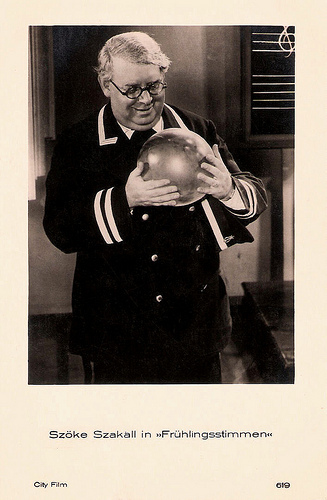
Dutch postcard by City Film, no. 619. Photo: publicity still for Frühlingsstimmen/Voices of Springtime (Pál Fejös, 1933).

German postcard, no. 6763/1, 1931-1932. Photo: Atelier Binder, Berlin.

Dutch postcard by City Film.
Cuddles
Producer Joe Pasternak had invited Szöke Szakáll in 1940 to come to the US. His first Hollywood role as S.Z. Sakall was in the comedy It's a Date (William A. Seiter, 1940) opposite Deanna Durbin.
Memorable was his turn as a butler in the comedy The Devil and Miss Jones (Sam Wood, 1941) with Jean Arthur. His first big hit was Ball of Fire (Howard Hawks, 1941) with Gary Cooper and Barbara Stanwyck.
Later, he signed a contract with Warner Brothers. There he was unforgettable as Carl, the head waiter in Casablanca (Michael Curtiz, 1942) and as a somewhat lecherous Broadway producer in the biography/musical Yankee Doodle Dandy (Michael Curtiz, 1942) with James Cagney.
Producer Hal Wallis had signed Sakall for the role of Carl in Casablanca three weeks after filming had begun. When he was first offered the part, Sakall hated it and turned it down. Sakall finally agreed to take the role provided they gave him four weeks of work. The two sides eventually agreed on three weeks.
In the 1940s and 1950s, he played many more supporting roles in comedies and musicals, often as a lovable somewhat befuddled uncle, businessman or neighbourhood eccentric. His nickname became Cuddles. He was famous for using the phrase 'everything hunky dory'.
Among his films of the 1940s are Christmas in Connecticut (Peter Godfrey, 1945) with Barbara Stanwyck, the drama Embraceable You (Felix Jacoves, 1948) and Michael Curtiz's Romance on the High Seas (1948) - Doris Day's film debut.
His films of the 1950s included two more musicals with Doris Day, Tea for Two (David Butler, 1950) and Lullaby of Broadway (David Butler, 1951), and the Errol Flynn Western Montana (Ray Enright, 1950).
His last movie was the musical The Student Prince (Richard Thorpe, 1954). That year, Szöke Szakáll retired from films and he died of a heart attack a year later in Los Angeles, ten days after his 72nd birthday.

Dutch postcard, no. 504. Photo: Filma.

Belgian postcard, offered by Nieuwe Merksemsche Chocolaterie S.P.R.L., Merksem (Anvers). Photo: Warner Bros.
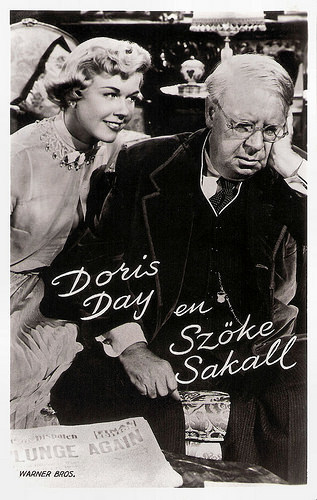
Dutch postcard by Takken / 't Sticht, no. AX 343. Photo: Warner Bros. Publicity still for Tea for Two (David Butler, 1950), the first film for which Doris Day received top-billing.

Dutch postcard by Takken / 't Sticht, no. AX 631. Photo: Warner Bros. Publicity still for Lullaby of Broadway ( (David Butler, 1951) with Doris Day.
Sources: Wikipedia and .

Austrian postcard by Iris-Verlag, no. 6539. Photo: Kiba-Verl. / Felsom-Film. Publicity still for Mädchen zum Heiraten/Girls to marry (Wilhelm Thiele, 1932).

German postcard by Ross Verlag, no. 7339/1, 1932-1933. Photo: Atelier Binder, Berlin.

British postcard in the Picturegoer series, London, no. W 865. Photo: Warner Bros.
Blonde Beard
Szöke Szakáll was born Gerő Jenő in Budapest, Austria-Hungary (now Hungary) in 1883 (some sources say 1882 or 1884). His stage name Szöke Szakáll means in Hungarian 'blonde beard'. At 18, he was called so as a young writer and aspiring actor because he wore a beard to look older.
The actor became a star of the Hungarian stage and screen in the 1910s and early 1920s. His films included Az újszülött apa/The newborn dad (Eugen Illés, 1916) and A dollárnéni/The dollar (Lajos Lázár, 1917).
At the beginning of the 1920s, he moved to Vienna, where he appeared in Hermann Leopoldi's Kabarett Leopoldi-Wiesenthal. One of his first film roles there was in Familientag im Hause Prellstein/Family Day in House Prellstein (Hans Steinhoff, 1927) with Erika Glässner .
The next years, he appeared in dozens of films including Großstadtschmetterling/Pavement Butterfly (Richard Eichberg, 1929) starring Anna May Wong , and in Ihre Majestät die Liebe/Her Majesty Love (Joe May, 1931) starring Käthe von Nagy , which was remade in Hollywood as Her Majesty, Love (William Dieterle, 1931) with W.C. Fields in Szákall's role.
In the 1930s, he was, next to Hans Moser , the most significant representative of the Wiener Film, the Viennese light romantic comedy genre. For a brief period during this time, he ran his own production company.
Szákall was forced to return to Hungary, because of the rise of Adolf Hitler and the Nazi movement. He was involved in over 40 films in his native land, including Skandal in Budapest/Romance in Budapest (Steve Sekely, Géza von Bolváry, 1933) and Fräulein Lilli/Miss Lilli (Hans Behrendt, Robert Wohlmuth, 1936), both starring Franziska Gaàl .
When Hungary joined the Axis in 1940, he went in exile with his wife. Many of Szákall's close relatives later died in Nazi concentration camps, including all three of his sisters and his niece, as well as his wife's brother and sister.

Dutch postcard by JosPe, Arnhem, no. 385. Photo: City Film. Liane Haid , Gustav Fröhlich and Szöke Szákall were the stars of the German comedy Ich will nicht wissen, wer du bist/I Do Not Want to Know Who You Are (Géza von Bolváry, 1932).

Dutch postcard by City Film, no. 619. Photo: publicity still for Frühlingsstimmen/Voices of Springtime (Pál Fejös, 1933).

German postcard, no. 6763/1, 1931-1932. Photo: Atelier Binder, Berlin.

Dutch postcard by City Film.
Cuddles
Producer Joe Pasternak had invited Szöke Szakáll in 1940 to come to the US. His first Hollywood role as S.Z. Sakall was in the comedy It's a Date (William A. Seiter, 1940) opposite Deanna Durbin.
Memorable was his turn as a butler in the comedy The Devil and Miss Jones (Sam Wood, 1941) with Jean Arthur. His first big hit was Ball of Fire (Howard Hawks, 1941) with Gary Cooper and Barbara Stanwyck.
Later, he signed a contract with Warner Brothers. There he was unforgettable as Carl, the head waiter in Casablanca (Michael Curtiz, 1942) and as a somewhat lecherous Broadway producer in the biography/musical Yankee Doodle Dandy (Michael Curtiz, 1942) with James Cagney.
Producer Hal Wallis had signed Sakall for the role of Carl in Casablanca three weeks after filming had begun. When he was first offered the part, Sakall hated it and turned it down. Sakall finally agreed to take the role provided they gave him four weeks of work. The two sides eventually agreed on three weeks.
In the 1940s and 1950s, he played many more supporting roles in comedies and musicals, often as a lovable somewhat befuddled uncle, businessman or neighbourhood eccentric. His nickname became Cuddles. He was famous for using the phrase 'everything hunky dory'.
Among his films of the 1940s are Christmas in Connecticut (Peter Godfrey, 1945) with Barbara Stanwyck, the drama Embraceable You (Felix Jacoves, 1948) and Michael Curtiz's Romance on the High Seas (1948) - Doris Day's film debut.
His films of the 1950s included two more musicals with Doris Day, Tea for Two (David Butler, 1950) and Lullaby of Broadway (David Butler, 1951), and the Errol Flynn Western Montana (Ray Enright, 1950).
His last movie was the musical The Student Prince (Richard Thorpe, 1954). That year, Szöke Szakáll retired from films and he died of a heart attack a year later in Los Angeles, ten days after his 72nd birthday.

Dutch postcard, no. 504. Photo: Filma.

Belgian postcard, offered by Nieuwe Merksemsche Chocolaterie S.P.R.L., Merksem (Anvers). Photo: Warner Bros.

Dutch postcard by Takken / 't Sticht, no. AX 343. Photo: Warner Bros. Publicity still for Tea for Two (David Butler, 1950), the first film for which Doris Day received top-billing.

Dutch postcard by Takken / 't Sticht, no. AX 631. Photo: Warner Bros. Publicity still for Lullaby of Broadway ( (David Butler, 1951) with Doris Day.
Sources: Wikipedia and .
Published on July 29, 2018 22:00
July 28, 2018
Mercedes Brignone
Mercedes Brignone (1885-1967) was an Italian theatre, film and television actress. The peak of her career was during the silent era. Brignone was directed several times n screen by her brother, Guido Brignone.

Italian postcard by Varischi Artico & Co. Milano, no. 2027.

Italian postcard by Varischi Artico & Co. Milano, no. 2055.

Italian postcard by Varischi Artico & Co. Milano, no. 2061. Sent by mail in Belgium in 1917.
Neglected
Mercedes Brignone was born in Madrid, Spain in 1885. She was the daughter of Italian stage actor Giuseppe Brignone.
Already as a child, she started to perform with her father and became a lively comical actress. In 1903 she married actor Uberto Palmarini with whom she worked in the same theatre company.
Probably her first film role was in the short Il marito in campagna/The Husband in the Country (?, 1912), which co-starred Umberto Mozzato. It was an adaptation of the French boulevard comedy Le mari à la campagne by Jean-François Bayard and Jules de Wailly.
From 1914 she had a steady career in the Italian cinema, first in shorts but soon in feature-length films. Brignone starred in these films, which in 1914 were all Milano productions, often directed by Baldassarre Negroni and co-starring Livio Pavanelli and her husband, Uberto Palmarini.
Examples of these films are La corsa all’abisso/The Pace That Kills (Attilio Fabbri, 1914), La dote del burattinaio/The Puppet’s Dowry (Baldassarre Negroni, 1914), and Il re dell’Atlantico/The King of the Atlantic (Baldassarre Negroni, 1914).
Brignone left Milano and worked for several other companies. In 1915 she played in Mezzanotte/Midnight (Augusto Genina, 1915) and in the adaptation of Salvatore Di Giacomo’s play A San Francisco/In San Francisco (1915), directed by her co-star Gustavo Serena . San Francisco refers here to the former prison in Naples.
In 1916, Brignone again played with husband Palmarini in Medusa velata/Veiled Medusa (Ugo De Simone, 1916), and played with her brother Guido and his wife Lola Visconti-Brignone in Espiazione/Penitence (Mario Corte, 1916).
Brignone acted opposite Helena Makowska and Umberto Mozzato, the actor of her first film, in La Gioconda (Eleuterio Rodolfi, 1916). This film, based on Gabriele D’Annunzio’s play, narrates the bizarre story of a sculptor (Mozzato) who neglects his wife (Brignone) for his femme fatale-like model (Makowska). When the wife tries to save her marriage, the model wants to crush the sculpture for which she modelled. The wife tries to save the statue, but looses her hands in doing so.
The film is considered lost now, although if it was widespread at the time. Happily, the postcards of the film still exist.
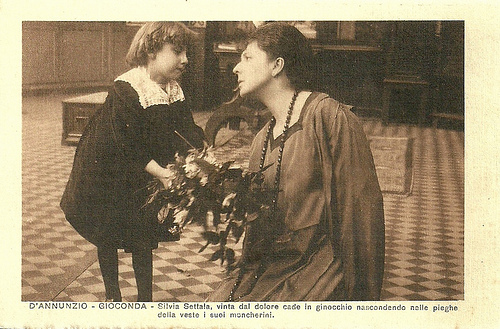
Mercedes Brignone in La Gioconda (1916). Italian postcard by IPA CT, no. 3660, 1917. Photo: Ambrosio.
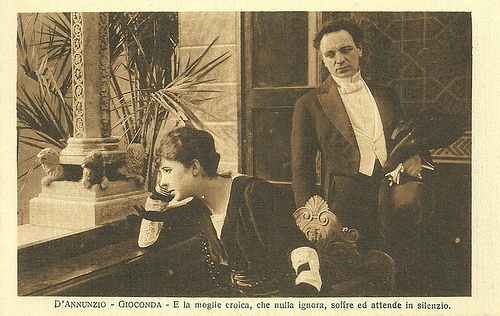
Mercedes Brignone and Umberto Mozzato in La Gioconda (1916). Italian postcard by ICA CT, no. 3670, 1916. Photo: Ambrosio.
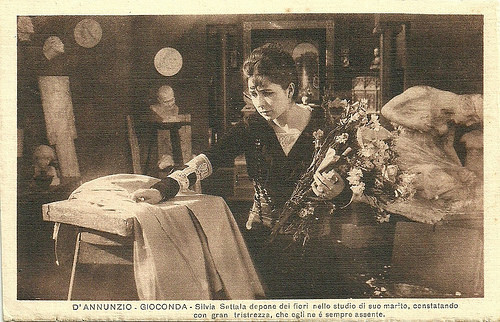
Italian postcard by IPA CT, no. 3871. Photo: Film della Società Ambrosio, Torino. V. Uff. Rev. St. Terni. Publicity still for La Gioconda (Eleuterio Rodolfi, 1916). Caption: Sivia Settala deposes flowers in the studio of her husband, noting with great sadness, that he is ever more absent.
Monstre Sacré
In 1917, Mercedes Brignone played in La flotta degli emigranti/The Fleet of the Emigrants (Leopoldo Carlucci, 1917) co-starring Ileana Leonidoff , Il delitto dell’opera/The crime of the work (Eleuterio Rodolfi, 1917), and Amleto/Hamlet (Eleuterio Rodolfi, 1917).
Amleto starred the monstre sacré of the Italian stage Ruggero Ruggeri as Hamlet opposite Brignone as Gertrud and Helena Makowska as Ophelia. Some years ago the film was found and restored.
Rodolfi had started his own company for which Brignone starred in various films: after Amleto followed Un dramma di Vittoriano Sardou/A Play by Victorien Sardou (Eleuterio Rodolfi, 1918), La signora Rebus/Mrs. Rebus (Eleuterio Rodolfi, 1918), Il buon Samaritano/The Good Samaritan (Eleuterio Rodolfi, 1919), a remake of Il marito in campagna/The Husband in the Countryside (Mario Almirante, 1920), and Il privilegio dell’amore/The Privilege of Love (Eleuterio Rodolfi, 1920).
In the film Il perfetto amore/The Perfect Love (1918), Mecedes Brignone was directed for the first time by her brother, Guido Brignone. From 1916 on, he had been active as a film director for the Cines company. Their next film together was Il quadro di Osvaldo Mars/The Portrait by Osvaldo Mars (Guido Brignone, 1921).
In this film, Mercedes Brignone plays a countess in this film who discovers that a daring painting will be exposed of her in a Salome outfit and nothing much more. She cuts the painting to pieces but is also accused of the murder of the painter. The film was recently found in South-America by the Bologna film archive and restored.
Il quadro di Osvaldo Mars intriguingly shows the double nature of the countess: restrained and violent, but Brignone also plays a double role of the lookalike of the countess, a farmer’s wife who leaves husband and child to climb the social ladder.
After Il quadro di Osvaldo Mars Guido Brignone directed his sister again in Le campane di San Lucio/The Bells of San Lucio (1921).
After that, Mercedes Brignone became the co-star of Il segreto del morto/The Secret of the Dead (Luigi Romano Borgnetto, 1922) with Carlo Aldini , I due sergenti/The Two Sergeants (Guido Brignone, 1922) with Giovanni Cimara – the film was based on a popular French novel that was often filmed in Italy - and Maciste e il nipote d’America/Maciste and the American Cousin (1924, Eleuterio Rodolfi), with as the legendary strongman, of course.

Italian postcard for the film Amleto (Eleuterio Rodolfi, 1917), adapted from Shakespeare's play Hamlet, and starring Ruggero Ruggeri in the title role, with Mercedes Brigone as Hamlet's mother, Queen Gertrude, while Polonius spies between the curtains. Caption: Hamlet: You mother, you committed a grave offense to my father.

Italian postcard for the film Amleto (Eleuterio Rodolfi, 1917) with Mercedes Brignone as Queen Gertrude and Armand Pouget as King Claudius. Caption: The wedding of Gertrud and Claudius: "Yes, him! That incestuous beast won to his shameful lust the will of my [most seeming-virtuous] queen." (spoken by The Ghost in Shakespeare's Hamlet).

Italian postcard for the film Amleto (Eleuterio Rodolfi, 1917) with Mercedes Brignone as Queen Gertrude and Armand Pouget as King Claudius. Caption: "Polonius: Your noble son is mad. Mad call I it". Unknown is who played Polonius.
Napoleon
After an interval of six years, Mercedes Brignone returned to the cinema as a governess in the first Italian sound film, La canzone dell'amore/The Song of Love (1930), starring Dria Paola .
By now Brignone had to be satisfied with smaller parts, as in Nerone/Nero (Alessandro Balsetti, 1930), La stella del cinema/The Film Star (Mario Almirante, 1931) featuring Leda Gloria , Corte d’Assise/Before the Jury (Guido Brignone) with Marcella Albani , Vivere/To Live (Guido Brignone, 1938) with opera singer Tito Schipa, and the comedy Il marchese di Ruvolito/The Marquis of Ruvolito (Raffaello Matarazzo, 1939) with the Napolitan brothers Eduardo and Peppino De Filippo.
In Sant’Elena, piccola isola/Saint Helen, Little Island (Umberto Scarpelli, Renato Simoni, 1943) Brignone played Madama Letizia vs. Ruggero Ruggeri as Bonaparte.
Other films she appeared in during the war period were La primadonna (Ivo Perilli, 1943) starring German actress Anneliese Uhlig , and Il fiore sotto gli occhi/The Flower under the Eyes (Guido Brignone, 1944) with Claudio Gora.
In the postwar era Mercedes Brignone worked for several theatre companies. She often played in comedies with Ruggero Ruggeri and Tino Carraro. She only incidentally appeared in films.
Her last (bit) parts were in Lorenzaccio (Raffaello Pacini, 1951) and Vacanze d’inverno/Winter Holidays (Camillo Mastrocinque, Giualiano Carnimeo, 1959) starring Michèle Morgan .
For RAI radio she acted in Aurelia (Enzo Ferrieri, 1949), while on television she could be seen in two stage plays, Romanticismo/Romanticism (1954), and Pane altrui/The Other's Bread (1957) and had a guest role in the series Le inchieste del commissario Maigret/The Investigations of Commissionar Maigret (1965), starring Gino Cervi .
Mercedes Brignone died in 1967 in Milan. She was the aunt of actress Lilla Brignone, the daughter of her brother Guido.

Italian postcard. Photo: Produzione Cines-Pittaluga. Publicity still for the courtcase melodrama Corte d'Assise (Guido Brignone, 1930), released in 1931. From left to right: Lya Franca, Renzo Ricci, Marcella Albani, and Mercedes Brignone, and far right Elio Steiner.

Italian postcard by Varischi Artico & Co, Milano, no. 2052.

Italian postcard by Varischi Artico & Co. Milano, no. 2074. Sent by mail in Belgium in 1906.

Italian postcard by NPG / Varischi Artico e C., Milano, no. 1.

Italian postcard, no. 58. Photo: Sciutto.
Sources: Vittorio Martinelli (Il cinema muto Italiano - Italian), Wikipedia (Italian) and .

Italian postcard by Varischi Artico & Co. Milano, no. 2027.

Italian postcard by Varischi Artico & Co. Milano, no. 2055.

Italian postcard by Varischi Artico & Co. Milano, no. 2061. Sent by mail in Belgium in 1917.
Neglected
Mercedes Brignone was born in Madrid, Spain in 1885. She was the daughter of Italian stage actor Giuseppe Brignone.
Already as a child, she started to perform with her father and became a lively comical actress. In 1903 she married actor Uberto Palmarini with whom she worked in the same theatre company.
Probably her first film role was in the short Il marito in campagna/The Husband in the Country (?, 1912), which co-starred Umberto Mozzato. It was an adaptation of the French boulevard comedy Le mari à la campagne by Jean-François Bayard and Jules de Wailly.
From 1914 she had a steady career in the Italian cinema, first in shorts but soon in feature-length films. Brignone starred in these films, which in 1914 were all Milano productions, often directed by Baldassarre Negroni and co-starring Livio Pavanelli and her husband, Uberto Palmarini.
Examples of these films are La corsa all’abisso/The Pace That Kills (Attilio Fabbri, 1914), La dote del burattinaio/The Puppet’s Dowry (Baldassarre Negroni, 1914), and Il re dell’Atlantico/The King of the Atlantic (Baldassarre Negroni, 1914).
Brignone left Milano and worked for several other companies. In 1915 she played in Mezzanotte/Midnight (Augusto Genina, 1915) and in the adaptation of Salvatore Di Giacomo’s play A San Francisco/In San Francisco (1915), directed by her co-star Gustavo Serena . San Francisco refers here to the former prison in Naples.
In 1916, Brignone again played with husband Palmarini in Medusa velata/Veiled Medusa (Ugo De Simone, 1916), and played with her brother Guido and his wife Lola Visconti-Brignone in Espiazione/Penitence (Mario Corte, 1916).
Brignone acted opposite Helena Makowska and Umberto Mozzato, the actor of her first film, in La Gioconda (Eleuterio Rodolfi, 1916). This film, based on Gabriele D’Annunzio’s play, narrates the bizarre story of a sculptor (Mozzato) who neglects his wife (Brignone) for his femme fatale-like model (Makowska). When the wife tries to save her marriage, the model wants to crush the sculpture for which she modelled. The wife tries to save the statue, but looses her hands in doing so.
The film is considered lost now, although if it was widespread at the time. Happily, the postcards of the film still exist.

Mercedes Brignone in La Gioconda (1916). Italian postcard by IPA CT, no. 3660, 1917. Photo: Ambrosio.

Mercedes Brignone and Umberto Mozzato in La Gioconda (1916). Italian postcard by ICA CT, no. 3670, 1916. Photo: Ambrosio.

Italian postcard by IPA CT, no. 3871. Photo: Film della Società Ambrosio, Torino. V. Uff. Rev. St. Terni. Publicity still for La Gioconda (Eleuterio Rodolfi, 1916). Caption: Sivia Settala deposes flowers in the studio of her husband, noting with great sadness, that he is ever more absent.
Monstre Sacré
In 1917, Mercedes Brignone played in La flotta degli emigranti/The Fleet of the Emigrants (Leopoldo Carlucci, 1917) co-starring Ileana Leonidoff , Il delitto dell’opera/The crime of the work (Eleuterio Rodolfi, 1917), and Amleto/Hamlet (Eleuterio Rodolfi, 1917).
Amleto starred the monstre sacré of the Italian stage Ruggero Ruggeri as Hamlet opposite Brignone as Gertrud and Helena Makowska as Ophelia. Some years ago the film was found and restored.
Rodolfi had started his own company for which Brignone starred in various films: after Amleto followed Un dramma di Vittoriano Sardou/A Play by Victorien Sardou (Eleuterio Rodolfi, 1918), La signora Rebus/Mrs. Rebus (Eleuterio Rodolfi, 1918), Il buon Samaritano/The Good Samaritan (Eleuterio Rodolfi, 1919), a remake of Il marito in campagna/The Husband in the Countryside (Mario Almirante, 1920), and Il privilegio dell’amore/The Privilege of Love (Eleuterio Rodolfi, 1920).
In the film Il perfetto amore/The Perfect Love (1918), Mecedes Brignone was directed for the first time by her brother, Guido Brignone. From 1916 on, he had been active as a film director for the Cines company. Their next film together was Il quadro di Osvaldo Mars/The Portrait by Osvaldo Mars (Guido Brignone, 1921).
In this film, Mercedes Brignone plays a countess in this film who discovers that a daring painting will be exposed of her in a Salome outfit and nothing much more. She cuts the painting to pieces but is also accused of the murder of the painter. The film was recently found in South-America by the Bologna film archive and restored.
Il quadro di Osvaldo Mars intriguingly shows the double nature of the countess: restrained and violent, but Brignone also plays a double role of the lookalike of the countess, a farmer’s wife who leaves husband and child to climb the social ladder.
After Il quadro di Osvaldo Mars Guido Brignone directed his sister again in Le campane di San Lucio/The Bells of San Lucio (1921).
After that, Mercedes Brignone became the co-star of Il segreto del morto/The Secret of the Dead (Luigi Romano Borgnetto, 1922) with Carlo Aldini , I due sergenti/The Two Sergeants (Guido Brignone, 1922) with Giovanni Cimara – the film was based on a popular French novel that was often filmed in Italy - and Maciste e il nipote d’America/Maciste and the American Cousin (1924, Eleuterio Rodolfi), with as the legendary strongman, of course.

Italian postcard for the film Amleto (Eleuterio Rodolfi, 1917), adapted from Shakespeare's play Hamlet, and starring Ruggero Ruggeri in the title role, with Mercedes Brigone as Hamlet's mother, Queen Gertrude, while Polonius spies between the curtains. Caption: Hamlet: You mother, you committed a grave offense to my father.

Italian postcard for the film Amleto (Eleuterio Rodolfi, 1917) with Mercedes Brignone as Queen Gertrude and Armand Pouget as King Claudius. Caption: The wedding of Gertrud and Claudius: "Yes, him! That incestuous beast won to his shameful lust the will of my [most seeming-virtuous] queen." (spoken by The Ghost in Shakespeare's Hamlet).

Italian postcard for the film Amleto (Eleuterio Rodolfi, 1917) with Mercedes Brignone as Queen Gertrude and Armand Pouget as King Claudius. Caption: "Polonius: Your noble son is mad. Mad call I it". Unknown is who played Polonius.
Napoleon
After an interval of six years, Mercedes Brignone returned to the cinema as a governess in the first Italian sound film, La canzone dell'amore/The Song of Love (1930), starring Dria Paola .
By now Brignone had to be satisfied with smaller parts, as in Nerone/Nero (Alessandro Balsetti, 1930), La stella del cinema/The Film Star (Mario Almirante, 1931) featuring Leda Gloria , Corte d’Assise/Before the Jury (Guido Brignone) with Marcella Albani , Vivere/To Live (Guido Brignone, 1938) with opera singer Tito Schipa, and the comedy Il marchese di Ruvolito/The Marquis of Ruvolito (Raffaello Matarazzo, 1939) with the Napolitan brothers Eduardo and Peppino De Filippo.
In Sant’Elena, piccola isola/Saint Helen, Little Island (Umberto Scarpelli, Renato Simoni, 1943) Brignone played Madama Letizia vs. Ruggero Ruggeri as Bonaparte.
Other films she appeared in during the war period were La primadonna (Ivo Perilli, 1943) starring German actress Anneliese Uhlig , and Il fiore sotto gli occhi/The Flower under the Eyes (Guido Brignone, 1944) with Claudio Gora.
In the postwar era Mercedes Brignone worked for several theatre companies. She often played in comedies with Ruggero Ruggeri and Tino Carraro. She only incidentally appeared in films.
Her last (bit) parts were in Lorenzaccio (Raffaello Pacini, 1951) and Vacanze d’inverno/Winter Holidays (Camillo Mastrocinque, Giualiano Carnimeo, 1959) starring Michèle Morgan .
For RAI radio she acted in Aurelia (Enzo Ferrieri, 1949), while on television she could be seen in two stage plays, Romanticismo/Romanticism (1954), and Pane altrui/The Other's Bread (1957) and had a guest role in the series Le inchieste del commissario Maigret/The Investigations of Commissionar Maigret (1965), starring Gino Cervi .
Mercedes Brignone died in 1967 in Milan. She was the aunt of actress Lilla Brignone, the daughter of her brother Guido.

Italian postcard. Photo: Produzione Cines-Pittaluga. Publicity still for the courtcase melodrama Corte d'Assise (Guido Brignone, 1930), released in 1931. From left to right: Lya Franca, Renzo Ricci, Marcella Albani, and Mercedes Brignone, and far right Elio Steiner.

Italian postcard by Varischi Artico & Co, Milano, no. 2052.

Italian postcard by Varischi Artico & Co. Milano, no. 2074. Sent by mail in Belgium in 1906.

Italian postcard by NPG / Varischi Artico e C., Milano, no. 1.

Italian postcard, no. 58. Photo: Sciutto.
Sources: Vittorio Martinelli (Il cinema muto Italiano - Italian), Wikipedia (Italian) and .
Published on July 28, 2018 22:00
July 27, 2018
Photo by Martin Badekow
The work of German photographer Martin Badekow (1896–1983) has been overlooked for a long time, but his photographs from the Berlin cabarets have become emblematic images of Weimar Germany. Vintage prints by Badekow are auctioned today for hundreds of dollars, but you can still find Ross Verlag postcards with his glamour portraits of film stars for the price of a bus fare.

Werner Krauss . German postcard by Ross Verlag, Berlin, no. 1613/1, 1927-1928. Photo: Atelier Badekow-Grosz, Berlin. Collection: Didier Hanson.

Werner Krauss . German postcard by Ross Verlag, Berlin, no. 1613/2, 1927-1928. Photo: Atelier Badekow-Grósz, Berlin.
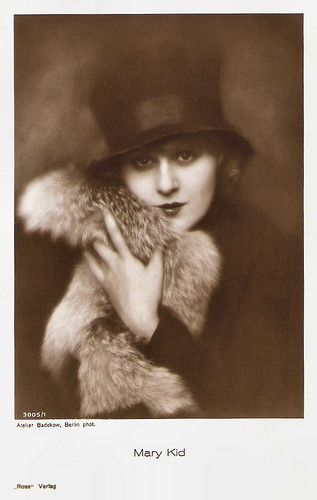
Mary Kid . German postcard by Ross Verlag, Berlin, no. 3005/1, 1928-1929. Photo: Atelier Badekow, Berlin.
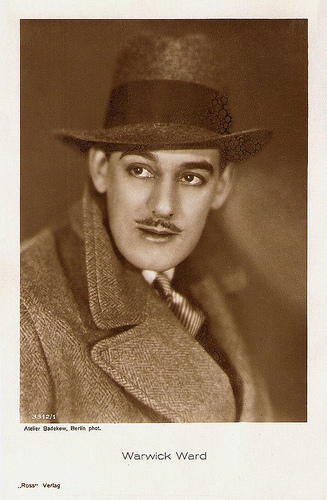
Warwick Ward . German postcard by Ross Verlag, Berlin, no. 3312/1, 1928-1929. Photo: Atelier Badekow, Berlin.
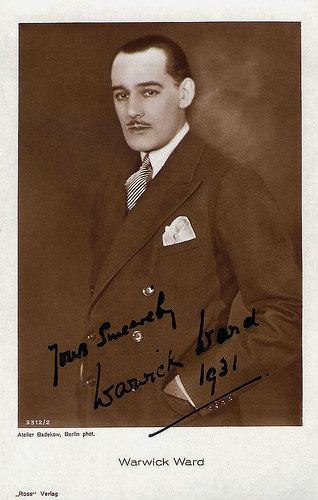
Warwick Ward . German postcard by Ross Verlag, no. 3312/2, 1928-1929. Signed in 1931. Photo: Atelier Badekow, Berlin.
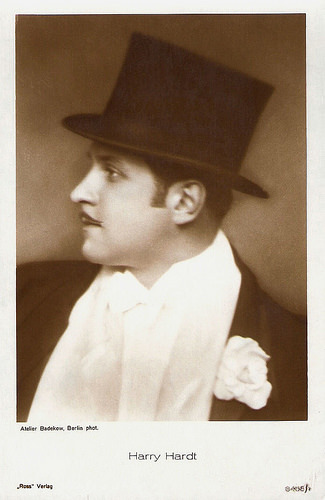
Harry Hardt . German postcard by Ross Verlag, no. 3406/1, 1928-1929. Photo: Atelier Badekow, Berlin.

Hanni Weisse . German postcard by Ross Verlag, no. 3459/1, 1928-1929. Photo: Atelier Badekow Berlin.
The famous Kurfürstendamm in Berlin
Martin Badekow had his photo studio, Atelier Badekow, at the famous Kurfürstendamm in Berlin. There he and his compagnon Grosz produced many fashion photos and celebrity portraits.
During the 1920s, Martin Badekow was frequently referred to in the German press as 'famous' or 'world renowned'. Many film stars came to his studio for glamour portraits, including Henny Porten , Dita Parlo and the beautiful exotic dancer La Jana .
The then still unknown Marlene Dietrich also often posed at Badekow's studio for fashion photos, showing her beautiful legs. Badekow sold the pictures to the many illustrated magazines in Berlin. However none of his portraits of Marlene were used for Ross Verlag postcards.
A well-known 1927 photo by Badekow shows Marlene playing the singing saw, which she had learned to play ffor the silent (!) film Café Elektric/Café Electric (Gustav Ucicky, 1927). Her teacher was co-star Igo Sym , who later became a Gestapo agent and was liquidated by the Polish resistance. During the second World War, Dietrich would let the saw sing again for the US troops.
After the war, Martin Badekow and his son Heinz (1920) photographed the ruins of Berlin. Their devastating pictures of the city can be seen at Getty Images, including one of the destroyed Kurfürstendamm. In the following decades Badekow slowly disappeared from the radar, till his work of the 1920s suddenly became the focus of revived interest.
And today, Martin Badekow's photographs from the Berlin cabarets and the stars of the silent German cinema can be admired in museums and are worshipped as emblematic images of Weimar Germany.

Ernst Verebes . German postcard by Ross Verlag, no. 3693/1, 1928-1929. Photo: Atelier Badekow, Berlin.

La Jana . German postcard by Ross Verlag, no. 3911, 1928-1929. Photo: Atelier Badekow, Berlin. Collection: Didier Hanson.

Dita Parlo . German postcard by Ross Verlag, no. 4591/1, 1929-1930. Photo: Atelier Badekow, Berlin.
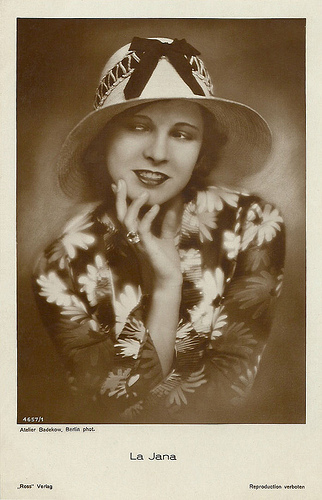
La Jana . German postcard by Ross Verlag, no. 4657/1, 1929-1930. Photo: Atelier Badekow, Berlin. Collection: Didier Hanson.
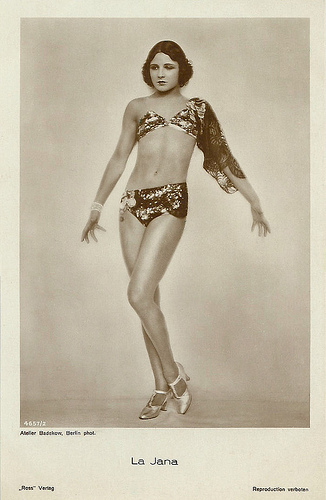
La Jana . German postcard by Ross Verlag, no. 4657/2, 1929-1930. Photo: Atelier Badekow, Berlin. Collection: Didier Hanson.

Grit Haid . German postcard by Ross Verlag, no. 4655/1, 1929-1930. Photo: Atelier Badekow, Berlin.

Marta Eggerth . German postcard by Ross Verlag, no. 6856/1, 1931-1932. Photo: Aafa Film / Phot. Atelier Badekow, Berlin.
Sources: Mark Goffee (Ross Postcards), One Man’s Treasure, Tagesspiegel (German) and AxelSpringer.de (German).

Werner Krauss . German postcard by Ross Verlag, Berlin, no. 1613/1, 1927-1928. Photo: Atelier Badekow-Grosz, Berlin. Collection: Didier Hanson.

Werner Krauss . German postcard by Ross Verlag, Berlin, no. 1613/2, 1927-1928. Photo: Atelier Badekow-Grósz, Berlin.

Mary Kid . German postcard by Ross Verlag, Berlin, no. 3005/1, 1928-1929. Photo: Atelier Badekow, Berlin.

Warwick Ward . German postcard by Ross Verlag, Berlin, no. 3312/1, 1928-1929. Photo: Atelier Badekow, Berlin.

Warwick Ward . German postcard by Ross Verlag, no. 3312/2, 1928-1929. Signed in 1931. Photo: Atelier Badekow, Berlin.

Harry Hardt . German postcard by Ross Verlag, no. 3406/1, 1928-1929. Photo: Atelier Badekow, Berlin.

Hanni Weisse . German postcard by Ross Verlag, no. 3459/1, 1928-1929. Photo: Atelier Badekow Berlin.
The famous Kurfürstendamm in Berlin
Martin Badekow had his photo studio, Atelier Badekow, at the famous Kurfürstendamm in Berlin. There he and his compagnon Grosz produced many fashion photos and celebrity portraits.
During the 1920s, Martin Badekow was frequently referred to in the German press as 'famous' or 'world renowned'. Many film stars came to his studio for glamour portraits, including Henny Porten , Dita Parlo and the beautiful exotic dancer La Jana .
The then still unknown Marlene Dietrich also often posed at Badekow's studio for fashion photos, showing her beautiful legs. Badekow sold the pictures to the many illustrated magazines in Berlin. However none of his portraits of Marlene were used for Ross Verlag postcards.
A well-known 1927 photo by Badekow shows Marlene playing the singing saw, which she had learned to play ffor the silent (!) film Café Elektric/Café Electric (Gustav Ucicky, 1927). Her teacher was co-star Igo Sym , who later became a Gestapo agent and was liquidated by the Polish resistance. During the second World War, Dietrich would let the saw sing again for the US troops.
After the war, Martin Badekow and his son Heinz (1920) photographed the ruins of Berlin. Their devastating pictures of the city can be seen at Getty Images, including one of the destroyed Kurfürstendamm. In the following decades Badekow slowly disappeared from the radar, till his work of the 1920s suddenly became the focus of revived interest.
And today, Martin Badekow's photographs from the Berlin cabarets and the stars of the silent German cinema can be admired in museums and are worshipped as emblematic images of Weimar Germany.

Ernst Verebes . German postcard by Ross Verlag, no. 3693/1, 1928-1929. Photo: Atelier Badekow, Berlin.

La Jana . German postcard by Ross Verlag, no. 3911, 1928-1929. Photo: Atelier Badekow, Berlin. Collection: Didier Hanson.

Dita Parlo . German postcard by Ross Verlag, no. 4591/1, 1929-1930. Photo: Atelier Badekow, Berlin.

La Jana . German postcard by Ross Verlag, no. 4657/1, 1929-1930. Photo: Atelier Badekow, Berlin. Collection: Didier Hanson.

La Jana . German postcard by Ross Verlag, no. 4657/2, 1929-1930. Photo: Atelier Badekow, Berlin. Collection: Didier Hanson.

Grit Haid . German postcard by Ross Verlag, no. 4655/1, 1929-1930. Photo: Atelier Badekow, Berlin.

Marta Eggerth . German postcard by Ross Verlag, no. 6856/1, 1931-1932. Photo: Aafa Film / Phot. Atelier Badekow, Berlin.
Sources: Mark Goffee (Ross Postcards), One Man’s Treasure, Tagesspiegel (German) and AxelSpringer.de (German).
Published on July 27, 2018 22:00
July 26, 2018
Bernhard Goetzke
With his sharply featured face, high forehead and low-lying eyes, German film actor Bernhard Goetzke (1884–1964) was one of the impressive stars of the silent films of Fritz Lang. He appeared in 130 films between 1917 and 1961.

German postcard by Ross Verlag, no. 3009/1, 1928-1929. Photo: Ufa.

German postcard by Ross Verlag, no. 675/4. Photo: Decla-Ufa-Film. Caption: Kriemhild (Margarethe Schön) gives Volkert (Bernhard Goetzke) Siegfried's cloak. Still for Die Nibelungen, II: Kriemhilds Rache (Fritz Lang, 1924).

German postcard by Ross Verlag, no. 497/1, 1919-1924. Photo: Alex Binder.
Ernst Lubitsch
Bernhard Goetzke was born in Danzig, Germany (now Gdańsk, Poland) in 1884.
After a private training as an actor, he performed in theatres in Düsseldorf, Hagen, and Dresden. During the First World War, he went to Berlin. There he played on many stages and worked under the famous director Max Reinhardt.
Goetzke started his film career in the 1910s. In 1917 he appeared with Conrad Veidt in the eerie dream-like Furcht/Fear (Robert Wiene, 1917).
This was soon followed by leading roles in the mystery Die Japanerin/The Japanese Woman (Ewald André Dupont, 1919) opposite Ria Jende , Anita Jo (Dimitri Buchowetzki, 1919) featuring Hanni Weisse , and Zwischen Tod und Leben/Between Life and Death (Arthur Wellin, 1919) with Alexander Moissi .
Goetzke had a supporting part in the international box office hit Madame DuBarry (Ernst Lubitsch, 1919) starring Pola Negri .
A second highlight was Die Brüder Karamasoff/The Brothers Karamazov (Carl Froelich, 1921), the first film version of Fyodor Dostoevsky’s famous novel. He played Iwan Karamazov, and Emil Jannings and Fritz Kortner as his (young and older) brother, the murderer Dimitri.
Another huge success was the two-part adventure epic Das indische Grabmal/The Indian Tomb (Joe May, 1921), in which Goetzke appeared as a sinister Yogi opposite Olaf Fönss and Mia May . His sharply featured face, high forehead and low-lying eyes as well as his long, slim form made him one of the most impressive appearances of the silent cinema.

German postcard by Ross Verlag, no. 672/4. Photo: Decla-Ufa-Film. Bernhard Goetzke as Volker von Alzey, the bard in Die Nibelungen (Fritz Lang, 1924). Costumes and sets of the film were inspired by Carl Otto Czeschka's book illustrations (1909) of Die Nibelungen.
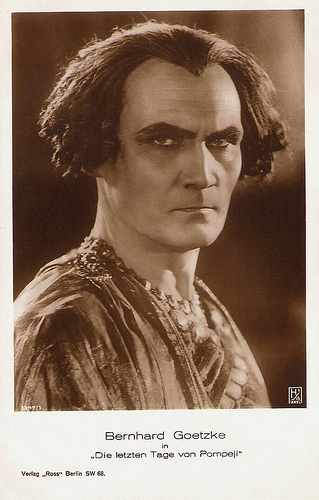
German postcard by. Ross Verlag, no. 1347/1. Photo: Hisa Film-Vertrieb. Bernhard Goetzke as the evil Egyptian priest Arbaces in the silent epic Gli ultimi giorni di Pompei/ The Last Days of Pompeii (Carmine Gallone, Amleto Palermi, 1926).

Austrian postcard by Iris Verlag, no. 677/2. Photo: Verleih E. Weil & Co.
Alfred Hitchcock
Bernhard Goetzke’s most notable film performance was his title role of Death in Fritz Lang’s Der müde Tod/Destiny (Fritz Lang, 1921). He worked again for Lang in Dr. Mabuse, der Spieler/Dr. Mabuse: The Gambler (Fritz Lang, 1922) the first in Lang's series of thrillers around the criminal mastermind Dr. Mabuse ( Rudolph Klein Rogge ).
Goetzke also played Volker von Alzey, the Bard, in Lang‘s epic fantasy Die Nibelungen (Fritz Lang, 1924).
Then he played the leading role of engineer Kramer in Gerhard Lamprecht‘s social drama Die Verrufenen/Slums of Berlin (Gerhard Lamprecht, 1925) with Aud Egede Nissen , and he also starred in the sequel Die Unehelichen/Children of No Importance (Gerhard Lamprecht, 1926).
In that same year Alfred Hitchcock directed him in the leading role of his romantic thriller The Mountain Eagle (1926), which was shot in München (Munich). He played a Kentucky shopkeeper in love with a teacher (Nita Naldi). When she refuses him, he accuses her from molesting his mentally ill son. Hitchcock also wrote the drama Die Prinzessin und der Geiger/The Blackguard (Graham Cutts, 1925) with Goetzke and in the title role Walter Rilla .
In Italy, Goetzke played in the historical epic Gli ultimi giorni di Pompeii/The Last Days of Pompeii (Carmine Gallone, Amleto Palermi, 1926) with Victor Varconi.
In France, he co-starred in the crime film Vivre/To Live (Robert Boudrioz, 1928) with Elmire Vautier . In France, he also played father Faria in a silent adaptation of Alexandre Dumas Père’s Monte Cristo (Henri Fescourt, 1929) starring Jean Angelo .
He had his last leading role in Salamandra/Salamander (Grigori Roshal, 1929), one of the first German-Soviet co-productions. It was a Socialist Realist distortion of Dr. Paul Kammerer's experiments in the inheritance of acquired character(istic)s: the conjecture that certain changes which the environment produces in an individual may spontaneously appear in the next generation.

German postcard by Ross Verlag, no. 1279/1, 1927-1928. Photo: Riess.

German postcard by Ross Verlag, no. 1517/1, 1927-1928. Photo: Atelier Hanns Schwarz.

French postcard by A. N. (A. Noyer), Paris, no. 135.
Alraune
When the sound film arrived, Bernhard Goetzke joined the fate of many of his colleagues and his film career went into decline. During the sound era, he only appeared in supporting roles.
In the interesting SciFi film Alraune/Daughter of Evil (Richard Oswald, 1930), he played one of the men who fall for the vamp Alraune, played by Brigitte Helm . In this sound version, Helm gives a different interpretation of the same part she had in the silent version two years earlier. She not only portrays Alraune, the artificially created girl who brings down men by the dozen but also her mother, a prostitute who agrees to take part in an experiment of artificial insemination.
Goetzke reunited with his former director Lamprecht and co-star Aud Egede Nissen for Zwischen Nacht und Morgen/Between Night and Dawn (Gerhard Lamprecht, 1931), but his role was only a minor one.
In Finland he played his last lead role as an old hunter in the drama Erämaan turvissa (Kalle Kaarna, Friedrich von Maydell, 1931). From then he played supporting or bit parts in dozens of run-of-the mill films.
Among the more interesting films are the Jules Verne adaptation Der Kurier des Zaren/The Czar's Courier (Richard Eichberg, 1936) starring Adolph Wohlbrück (aka Anton Walbrook) as Lt. Michael Strogoff, and the pro-Irish propaganda film Der Fuchs von Glenarvon/The Fox of Glenarvon (Max W. Kimmich, 1941) with Olga Tschechova .
He also played a small part in the notorious propaganda film Jus Süss/Jew Süss (Veit Harlan, 1941). His roles at the time were so small that his performances sometimes were not even credited.
After the war Goetzke only appeared in two films of the East-German DEFA studio, as a poor farmer in the classic children’s fantasy Das kalte Herz/The heart of Stone (Paul Verhoeven, 1950) with Lutz Moik , and as a priest in the biography Semmelweis - Retter der Mütter/Dr. Semmelweis (Georg C. Klaren, 1950).
He focused on his stage career, and till his death he was an ensemble member of the Staatlichen Schauspielbühnen Westberlins (the State Theatres of West Berlin). His final screen appearance was a bit role in the TV film Elisabeth von England/Elizabeth of England (Hanns Korngiebel, 1961) featuring Elisabeth Flickenschildt.
Bernhard Goetzke died in 1964 in West-Berlin. He was 80.

German postcard by Ross Verlag, no. 3526/1, 1928-1929. Photo: S. Brill, Paris.

German postcard by Ross Verlag, no. 3629/1, 1928-1929.
Sources: Volker Wachter (DEFA Filmsterne), Wikipedia (English and German), and .

German postcard by Ross Verlag, no. 3009/1, 1928-1929. Photo: Ufa.

German postcard by Ross Verlag, no. 675/4. Photo: Decla-Ufa-Film. Caption: Kriemhild (Margarethe Schön) gives Volkert (Bernhard Goetzke) Siegfried's cloak. Still for Die Nibelungen, II: Kriemhilds Rache (Fritz Lang, 1924).

German postcard by Ross Verlag, no. 497/1, 1919-1924. Photo: Alex Binder.
Ernst Lubitsch
Bernhard Goetzke was born in Danzig, Germany (now Gdańsk, Poland) in 1884.
After a private training as an actor, he performed in theatres in Düsseldorf, Hagen, and Dresden. During the First World War, he went to Berlin. There he played on many stages and worked under the famous director Max Reinhardt.
Goetzke started his film career in the 1910s. In 1917 he appeared with Conrad Veidt in the eerie dream-like Furcht/Fear (Robert Wiene, 1917).
This was soon followed by leading roles in the mystery Die Japanerin/The Japanese Woman (Ewald André Dupont, 1919) opposite Ria Jende , Anita Jo (Dimitri Buchowetzki, 1919) featuring Hanni Weisse , and Zwischen Tod und Leben/Between Life and Death (Arthur Wellin, 1919) with Alexander Moissi .
Goetzke had a supporting part in the international box office hit Madame DuBarry (Ernst Lubitsch, 1919) starring Pola Negri .
A second highlight was Die Brüder Karamasoff/The Brothers Karamazov (Carl Froelich, 1921), the first film version of Fyodor Dostoevsky’s famous novel. He played Iwan Karamazov, and Emil Jannings and Fritz Kortner as his (young and older) brother, the murderer Dimitri.
Another huge success was the two-part adventure epic Das indische Grabmal/The Indian Tomb (Joe May, 1921), in which Goetzke appeared as a sinister Yogi opposite Olaf Fönss and Mia May . His sharply featured face, high forehead and low-lying eyes as well as his long, slim form made him one of the most impressive appearances of the silent cinema.

German postcard by Ross Verlag, no. 672/4. Photo: Decla-Ufa-Film. Bernhard Goetzke as Volker von Alzey, the bard in Die Nibelungen (Fritz Lang, 1924). Costumes and sets of the film were inspired by Carl Otto Czeschka's book illustrations (1909) of Die Nibelungen.

German postcard by. Ross Verlag, no. 1347/1. Photo: Hisa Film-Vertrieb. Bernhard Goetzke as the evil Egyptian priest Arbaces in the silent epic Gli ultimi giorni di Pompei/ The Last Days of Pompeii (Carmine Gallone, Amleto Palermi, 1926).

Austrian postcard by Iris Verlag, no. 677/2. Photo: Verleih E. Weil & Co.
Alfred Hitchcock
Bernhard Goetzke’s most notable film performance was his title role of Death in Fritz Lang’s Der müde Tod/Destiny (Fritz Lang, 1921). He worked again for Lang in Dr. Mabuse, der Spieler/Dr. Mabuse: The Gambler (Fritz Lang, 1922) the first in Lang's series of thrillers around the criminal mastermind Dr. Mabuse ( Rudolph Klein Rogge ).
Goetzke also played Volker von Alzey, the Bard, in Lang‘s epic fantasy Die Nibelungen (Fritz Lang, 1924).
Then he played the leading role of engineer Kramer in Gerhard Lamprecht‘s social drama Die Verrufenen/Slums of Berlin (Gerhard Lamprecht, 1925) with Aud Egede Nissen , and he also starred in the sequel Die Unehelichen/Children of No Importance (Gerhard Lamprecht, 1926).
In that same year Alfred Hitchcock directed him in the leading role of his romantic thriller The Mountain Eagle (1926), which was shot in München (Munich). He played a Kentucky shopkeeper in love with a teacher (Nita Naldi). When she refuses him, he accuses her from molesting his mentally ill son. Hitchcock also wrote the drama Die Prinzessin und der Geiger/The Blackguard (Graham Cutts, 1925) with Goetzke and in the title role Walter Rilla .
In Italy, Goetzke played in the historical epic Gli ultimi giorni di Pompeii/The Last Days of Pompeii (Carmine Gallone, Amleto Palermi, 1926) with Victor Varconi.
In France, he co-starred in the crime film Vivre/To Live (Robert Boudrioz, 1928) with Elmire Vautier . In France, he also played father Faria in a silent adaptation of Alexandre Dumas Père’s Monte Cristo (Henri Fescourt, 1929) starring Jean Angelo .
He had his last leading role in Salamandra/Salamander (Grigori Roshal, 1929), one of the first German-Soviet co-productions. It was a Socialist Realist distortion of Dr. Paul Kammerer's experiments in the inheritance of acquired character(istic)s: the conjecture that certain changes which the environment produces in an individual may spontaneously appear in the next generation.

German postcard by Ross Verlag, no. 1279/1, 1927-1928. Photo: Riess.

German postcard by Ross Verlag, no. 1517/1, 1927-1928. Photo: Atelier Hanns Schwarz.

French postcard by A. N. (A. Noyer), Paris, no. 135.
Alraune
When the sound film arrived, Bernhard Goetzke joined the fate of many of his colleagues and his film career went into decline. During the sound era, he only appeared in supporting roles.
In the interesting SciFi film Alraune/Daughter of Evil (Richard Oswald, 1930), he played one of the men who fall for the vamp Alraune, played by Brigitte Helm . In this sound version, Helm gives a different interpretation of the same part she had in the silent version two years earlier. She not only portrays Alraune, the artificially created girl who brings down men by the dozen but also her mother, a prostitute who agrees to take part in an experiment of artificial insemination.
Goetzke reunited with his former director Lamprecht and co-star Aud Egede Nissen for Zwischen Nacht und Morgen/Between Night and Dawn (Gerhard Lamprecht, 1931), but his role was only a minor one.
In Finland he played his last lead role as an old hunter in the drama Erämaan turvissa (Kalle Kaarna, Friedrich von Maydell, 1931). From then he played supporting or bit parts in dozens of run-of-the mill films.
Among the more interesting films are the Jules Verne adaptation Der Kurier des Zaren/The Czar's Courier (Richard Eichberg, 1936) starring Adolph Wohlbrück (aka Anton Walbrook) as Lt. Michael Strogoff, and the pro-Irish propaganda film Der Fuchs von Glenarvon/The Fox of Glenarvon (Max W. Kimmich, 1941) with Olga Tschechova .
He also played a small part in the notorious propaganda film Jus Süss/Jew Süss (Veit Harlan, 1941). His roles at the time were so small that his performances sometimes were not even credited.
After the war Goetzke only appeared in two films of the East-German DEFA studio, as a poor farmer in the classic children’s fantasy Das kalte Herz/The heart of Stone (Paul Verhoeven, 1950) with Lutz Moik , and as a priest in the biography Semmelweis - Retter der Mütter/Dr. Semmelweis (Georg C. Klaren, 1950).
He focused on his stage career, and till his death he was an ensemble member of the Staatlichen Schauspielbühnen Westberlins (the State Theatres of West Berlin). His final screen appearance was a bit role in the TV film Elisabeth von England/Elizabeth of England (Hanns Korngiebel, 1961) featuring Elisabeth Flickenschildt.
Bernhard Goetzke died in 1964 in West-Berlin. He was 80.

German postcard by Ross Verlag, no. 3526/1, 1928-1929. Photo: S. Brill, Paris.

German postcard by Ross Verlag, no. 3629/1, 1928-1929.
Sources: Volker Wachter (DEFA Filmsterne), Wikipedia (English and German), and .
Published on July 26, 2018 22:00
Paul van Yperen's Blog
- Paul van Yperen's profile
- 13 followers
Paul van Yperen isn't a Goodreads Author
(yet),
but they
do have a blog,
so here are some recent posts imported from
their feed.



